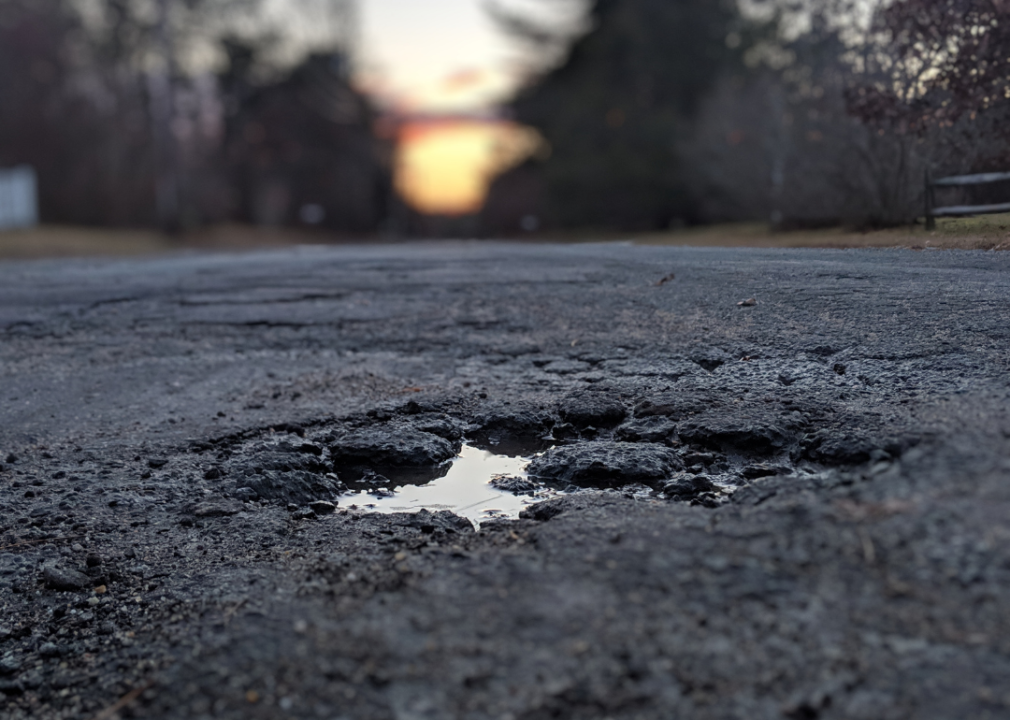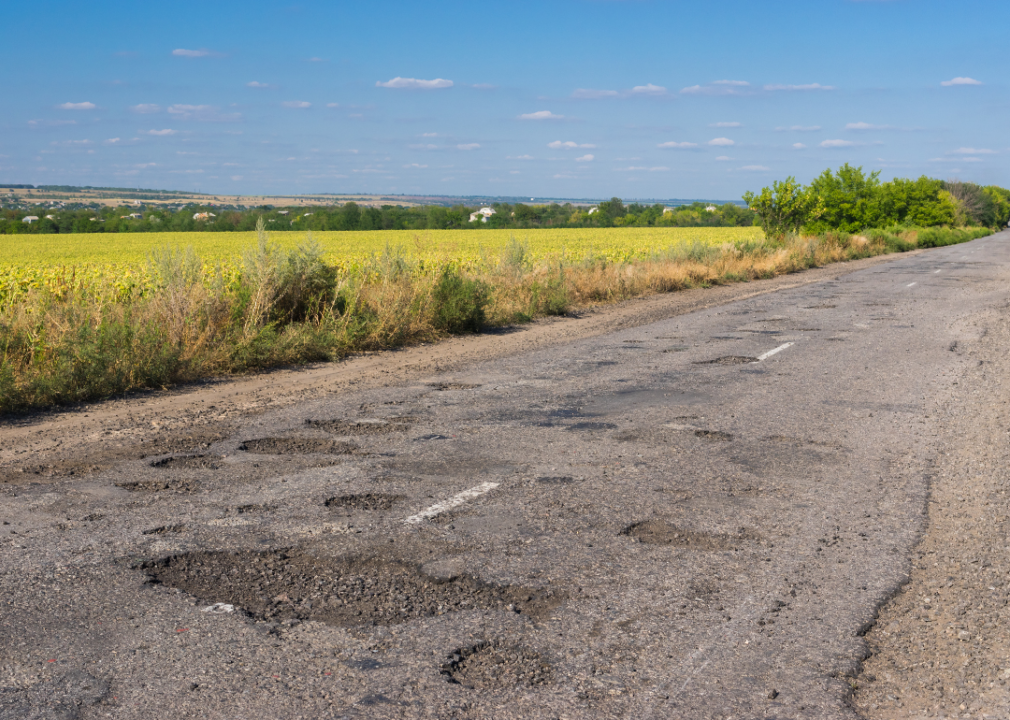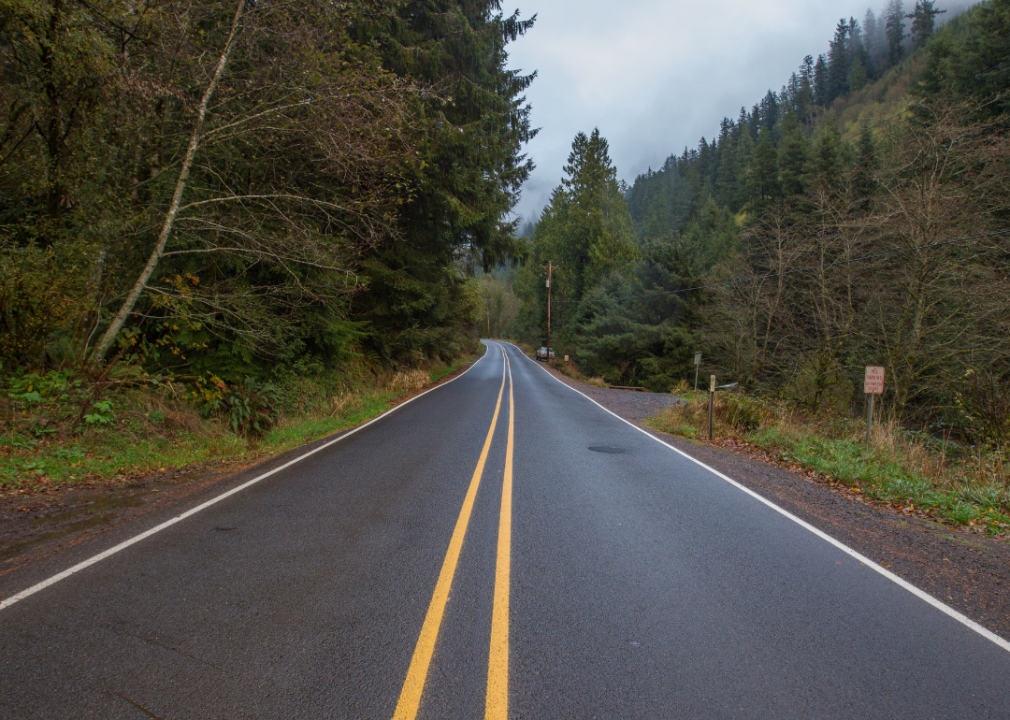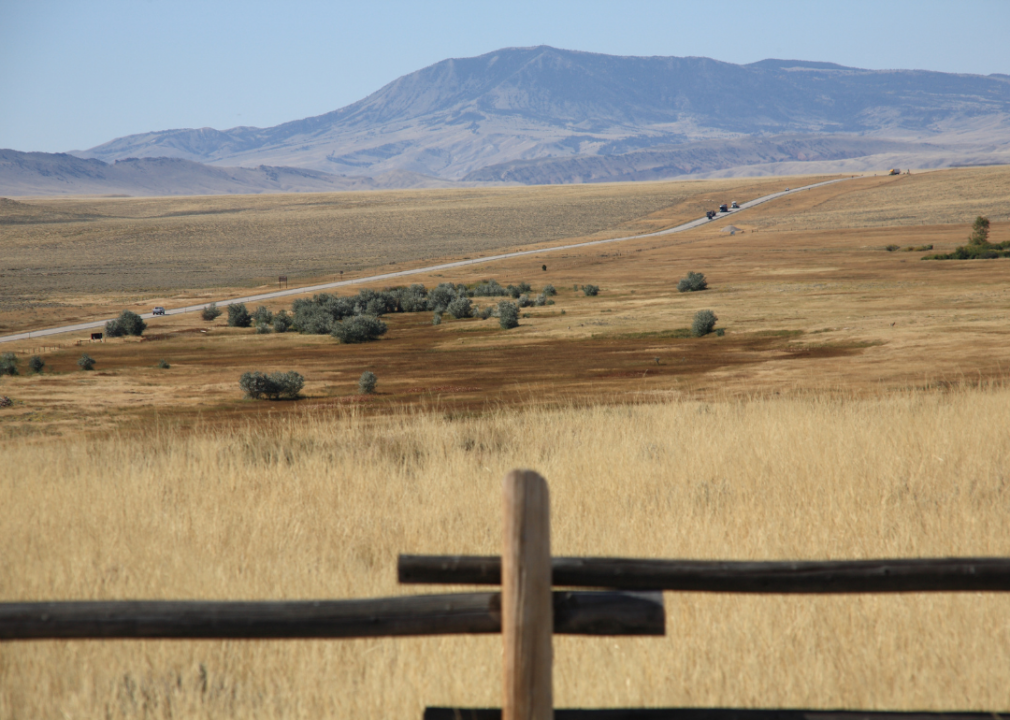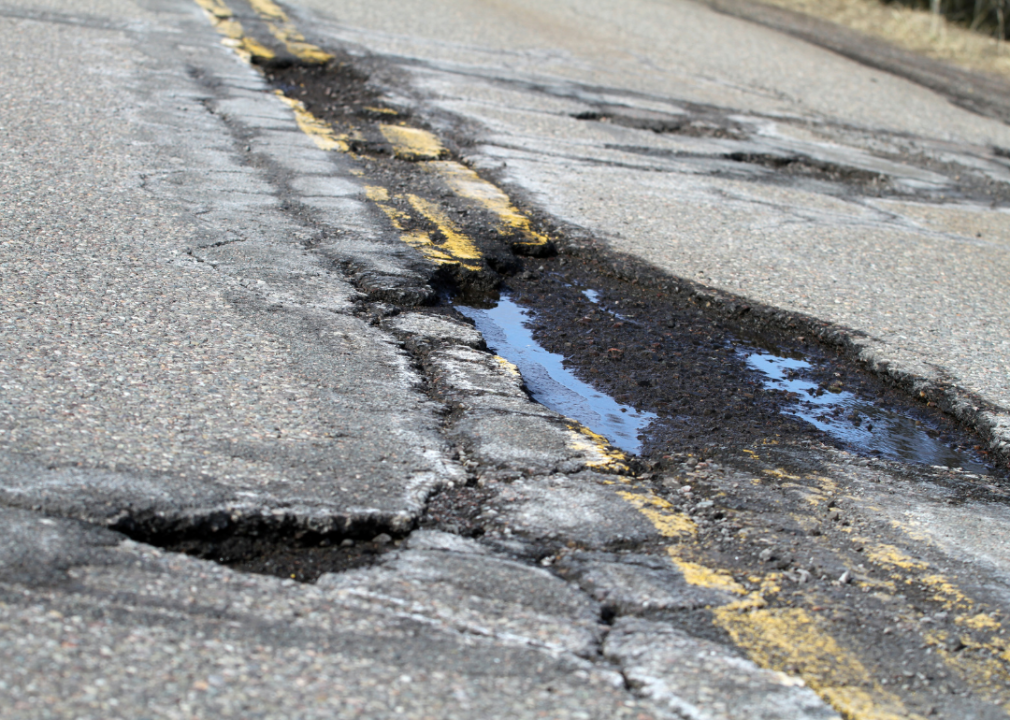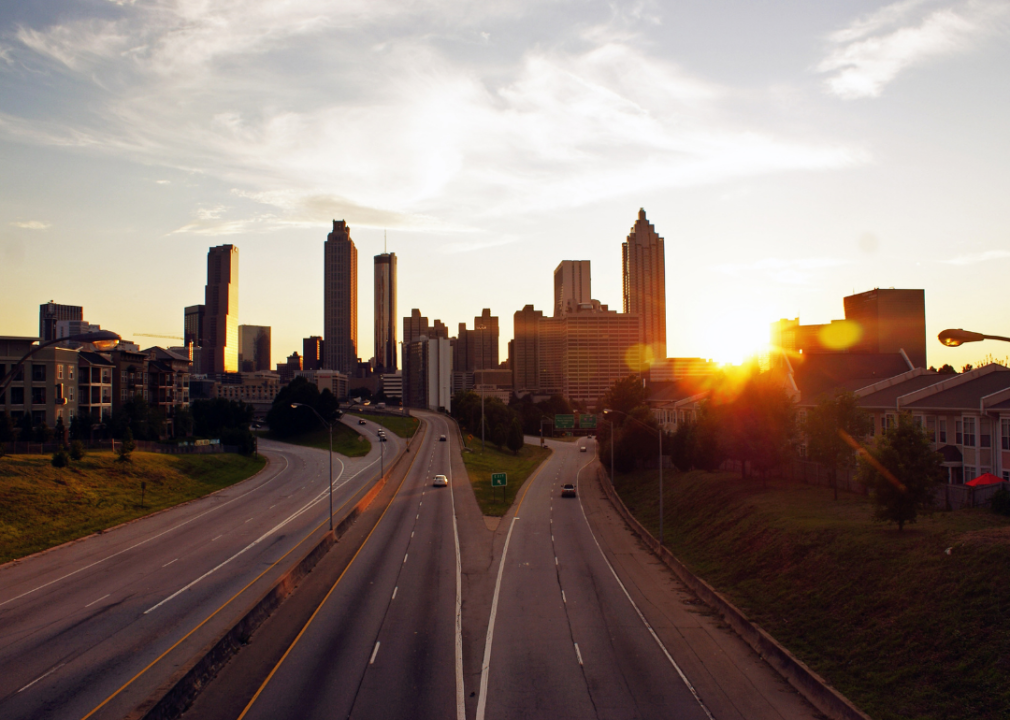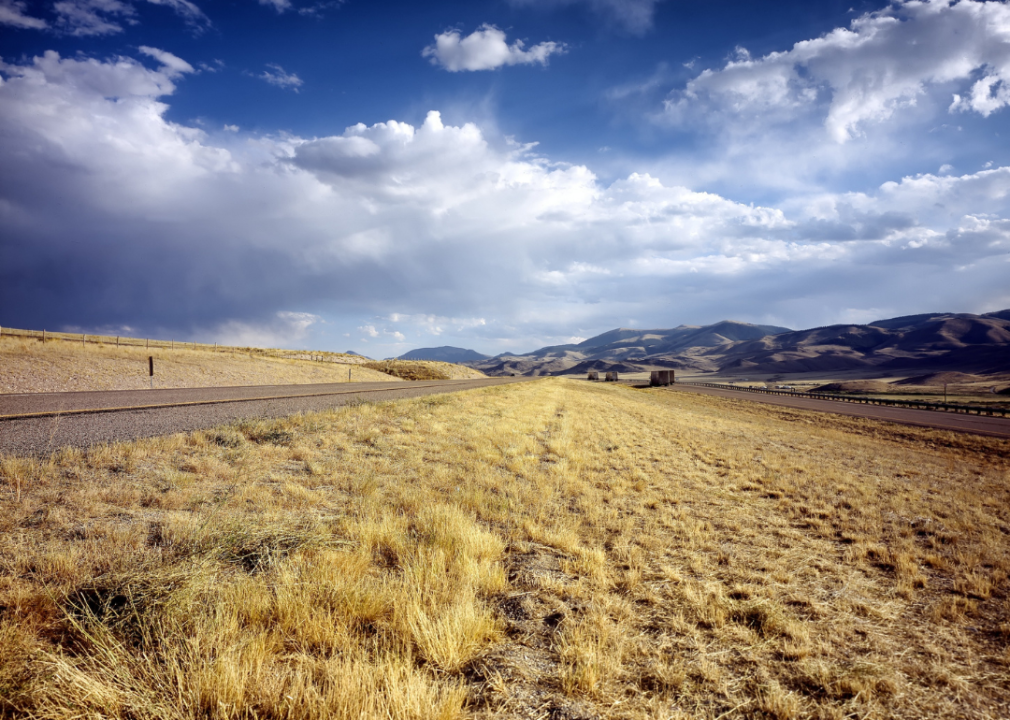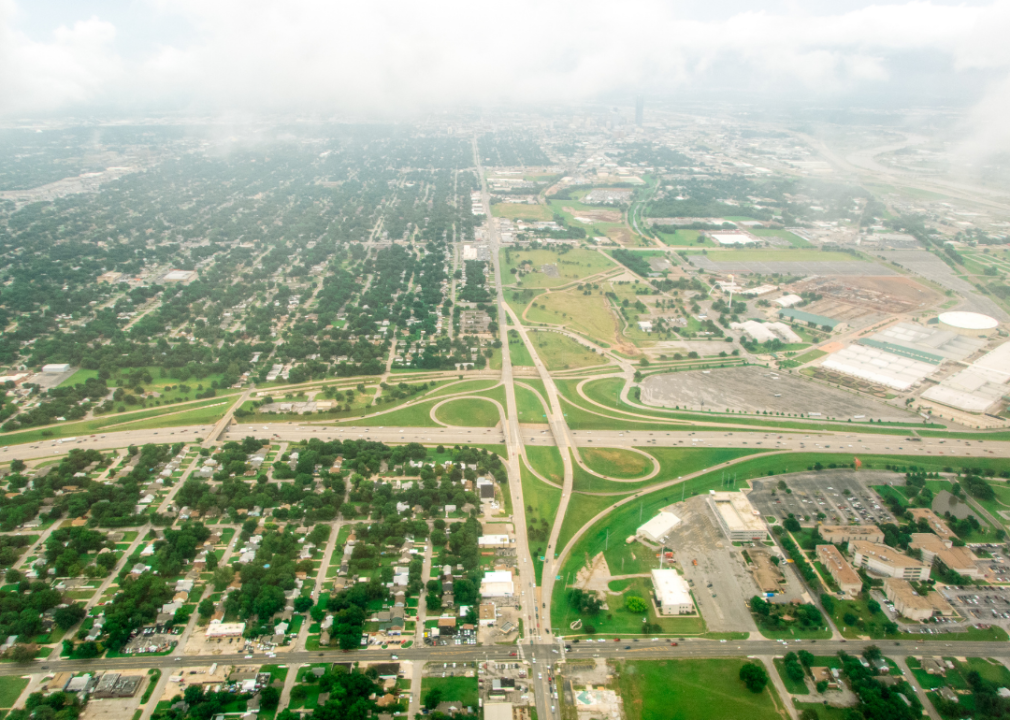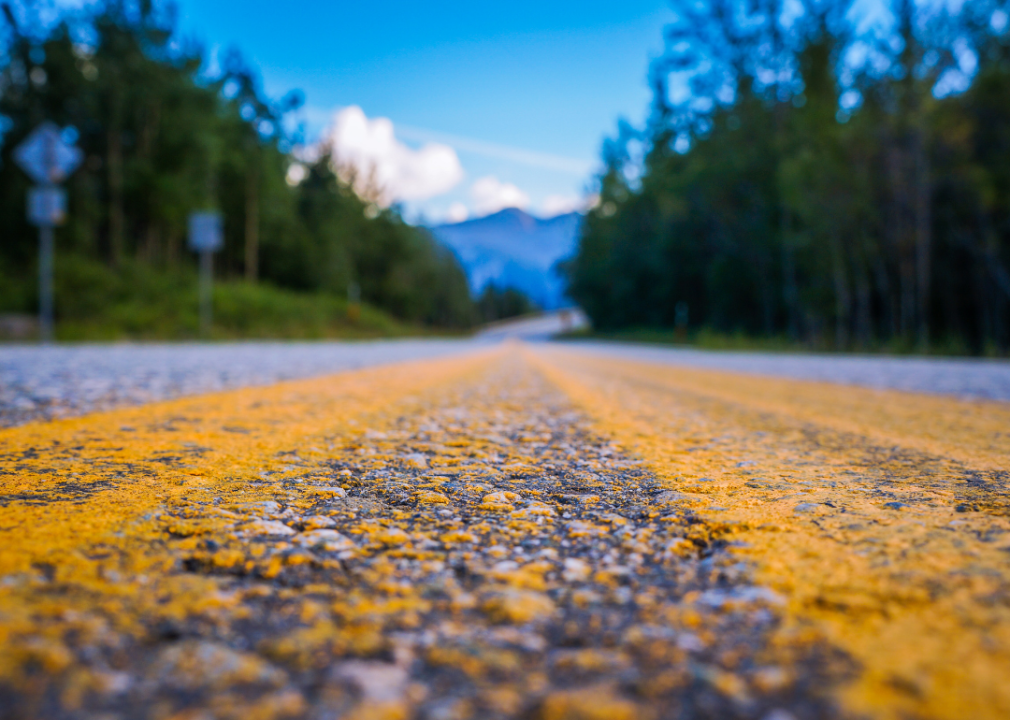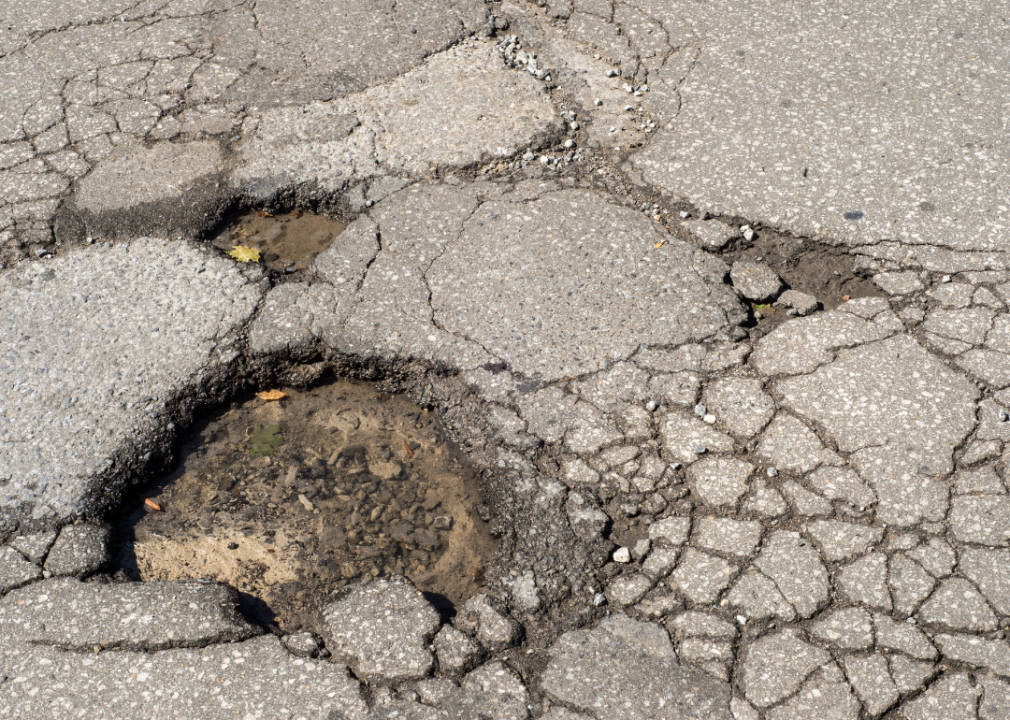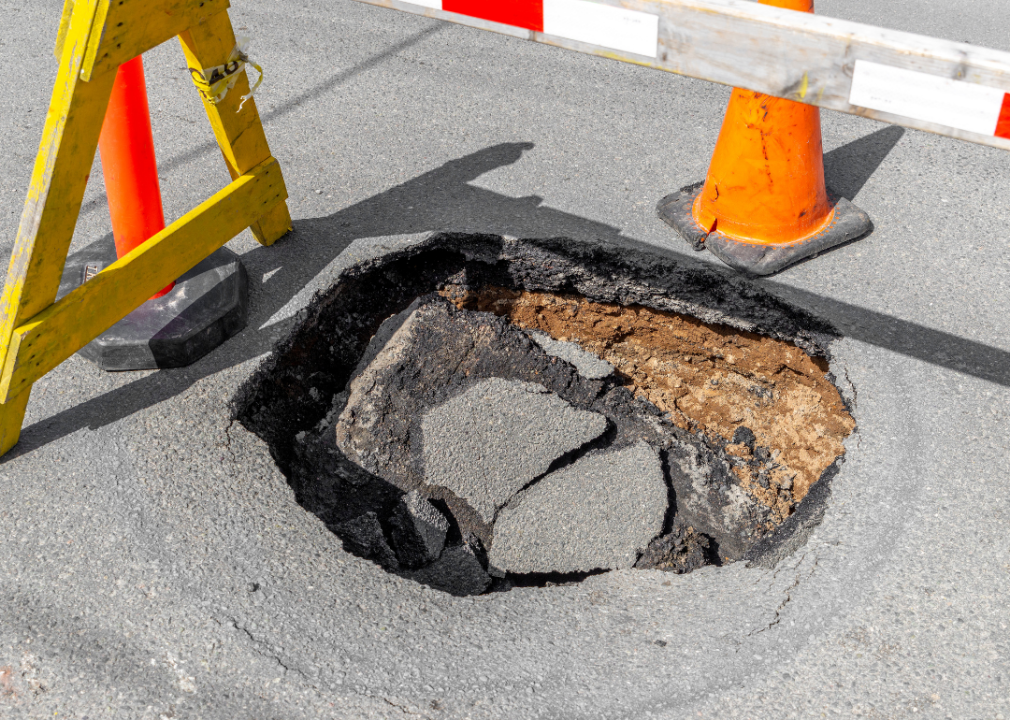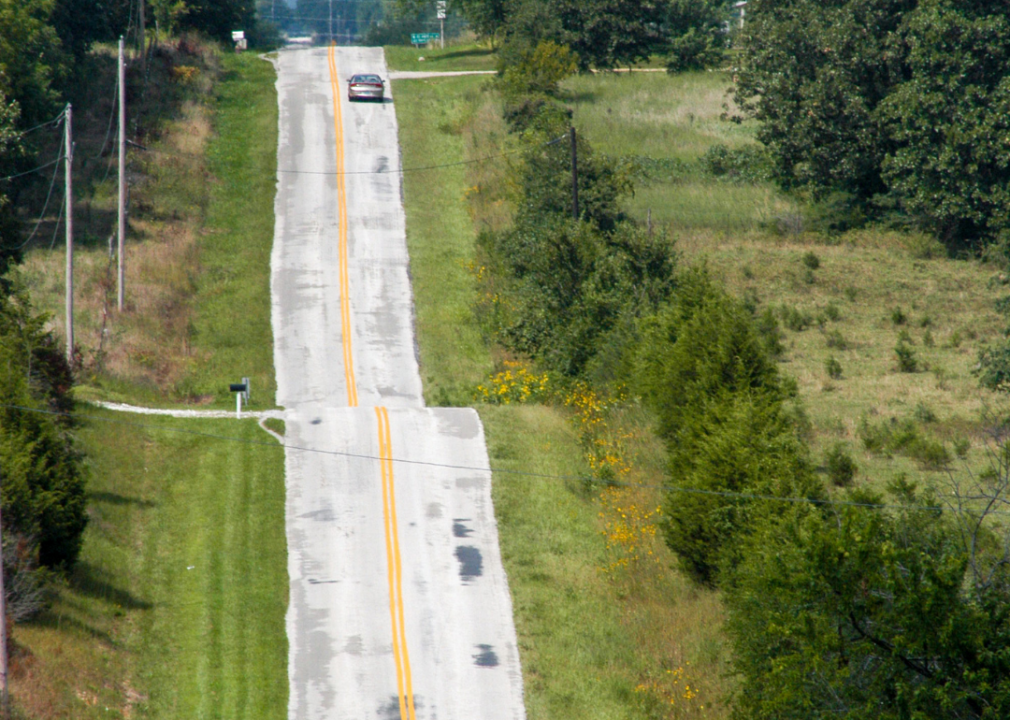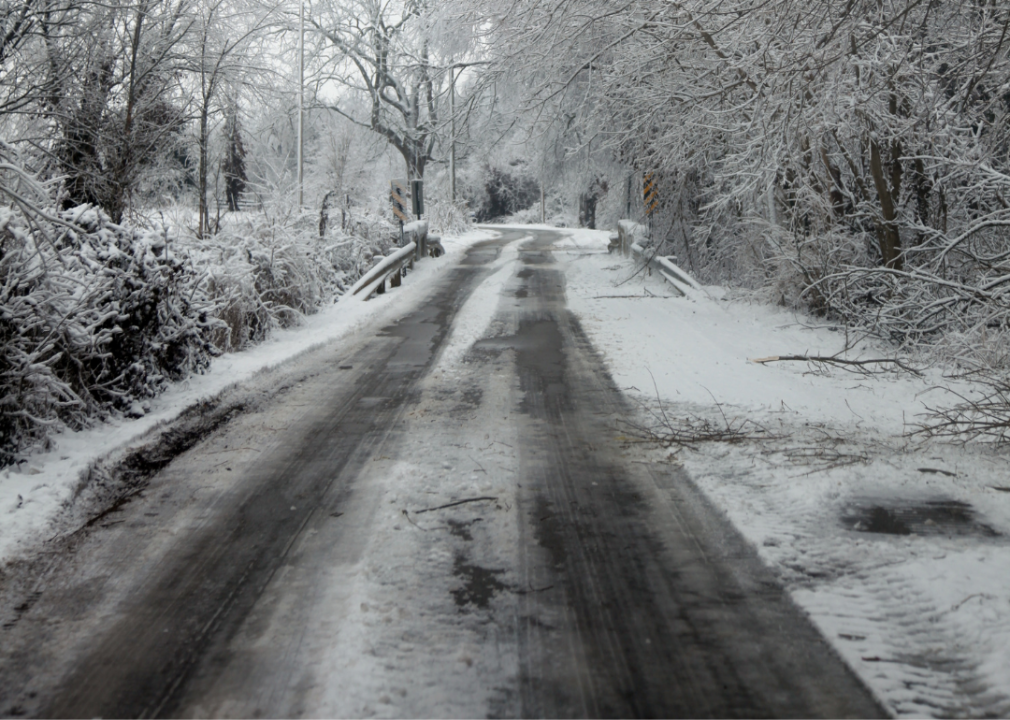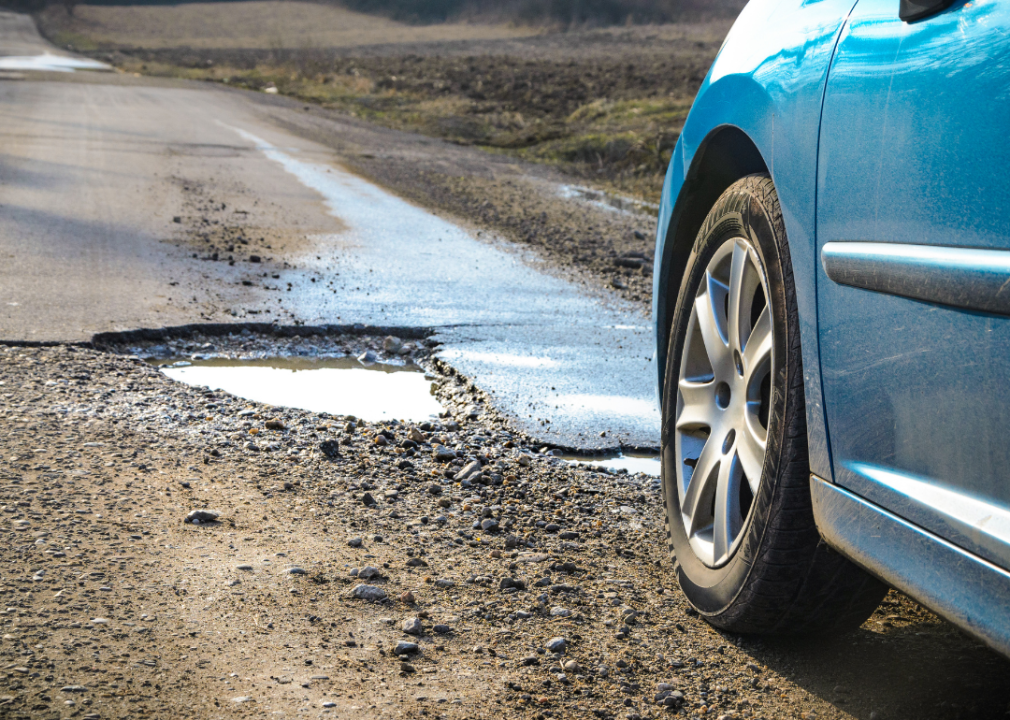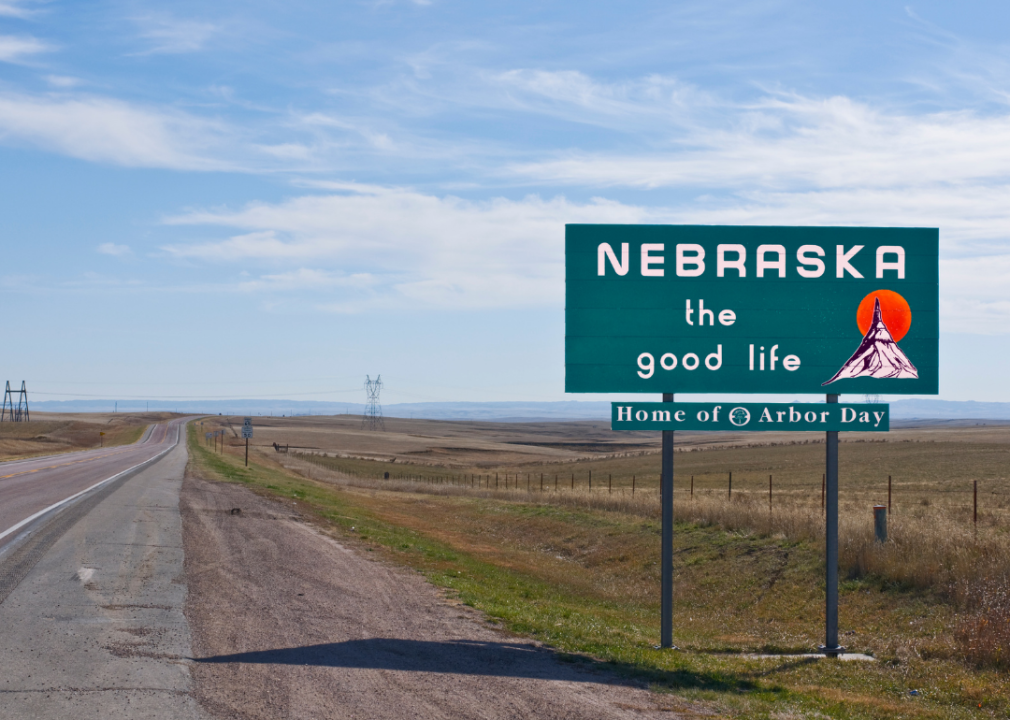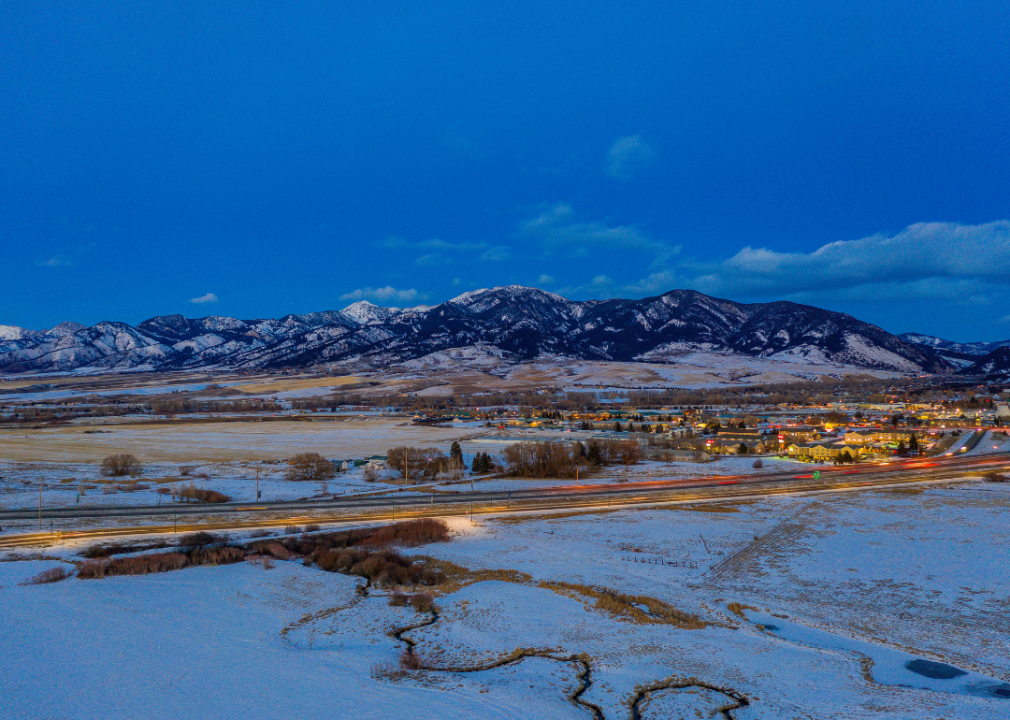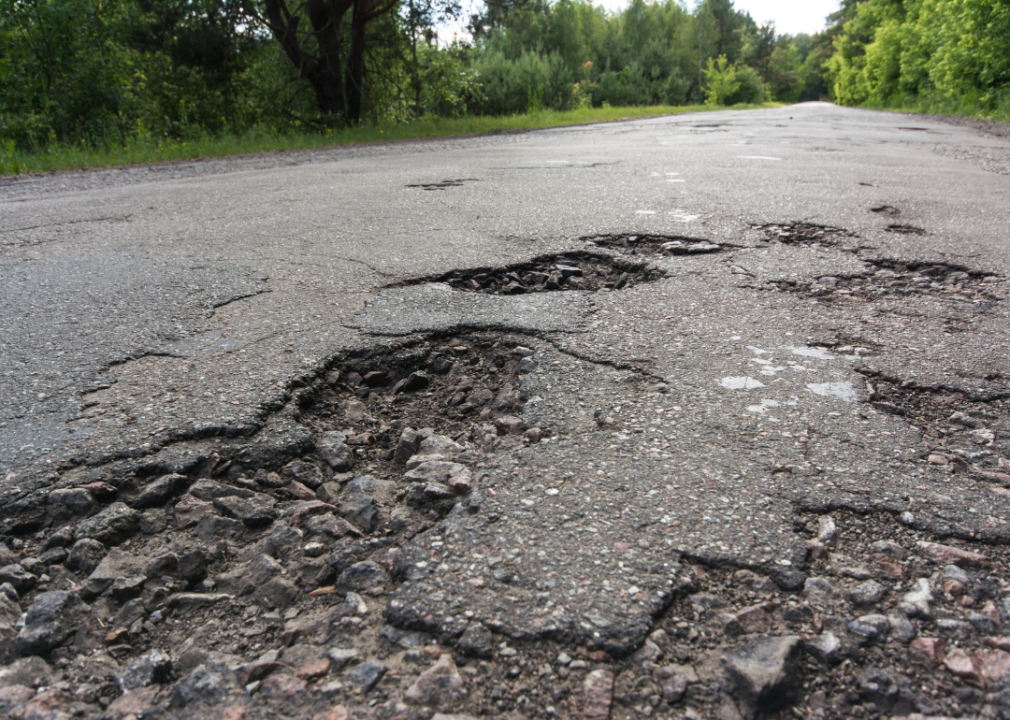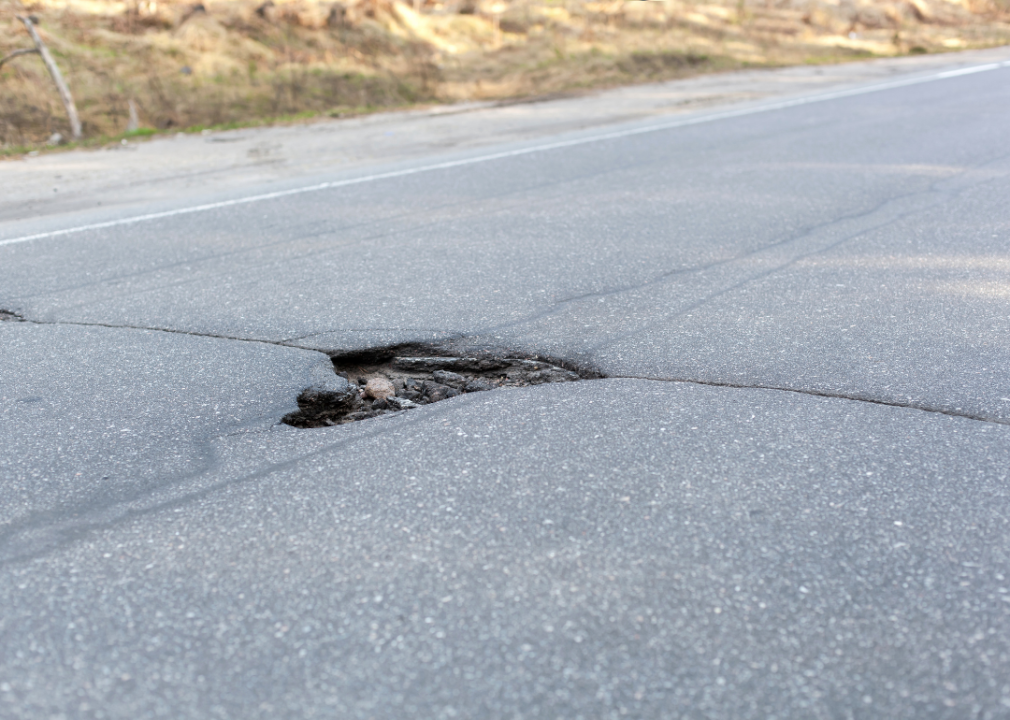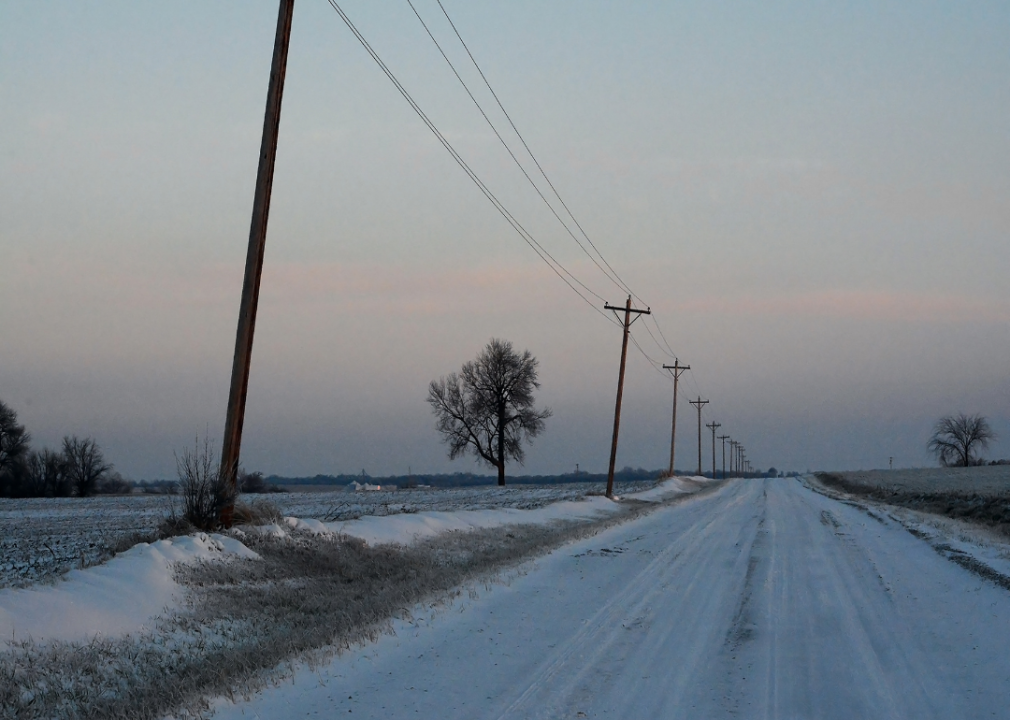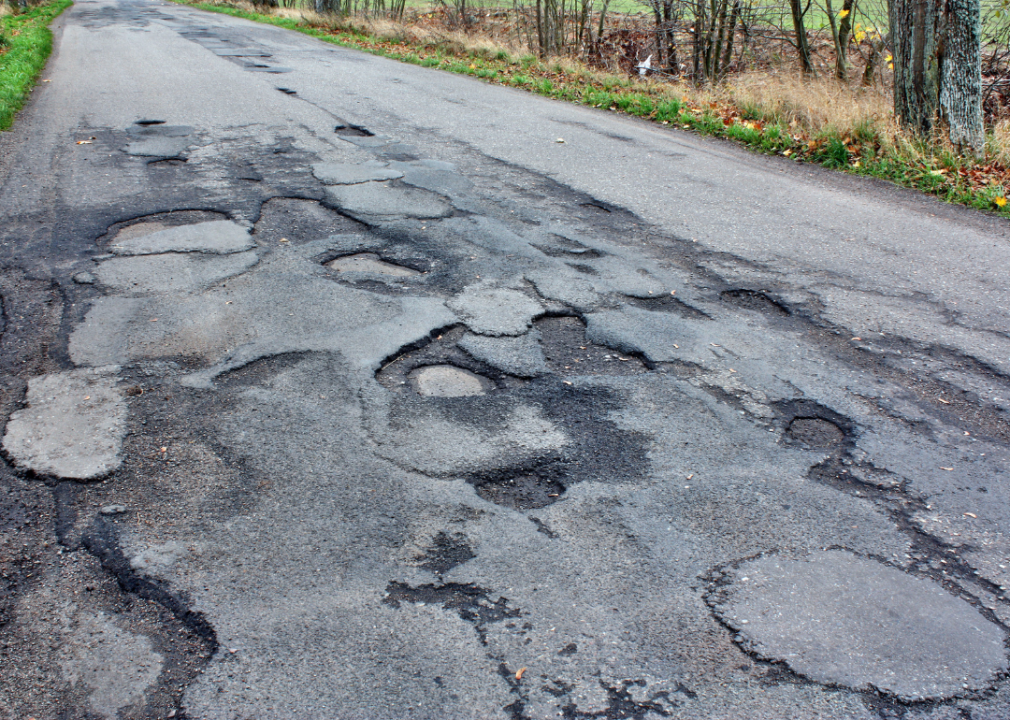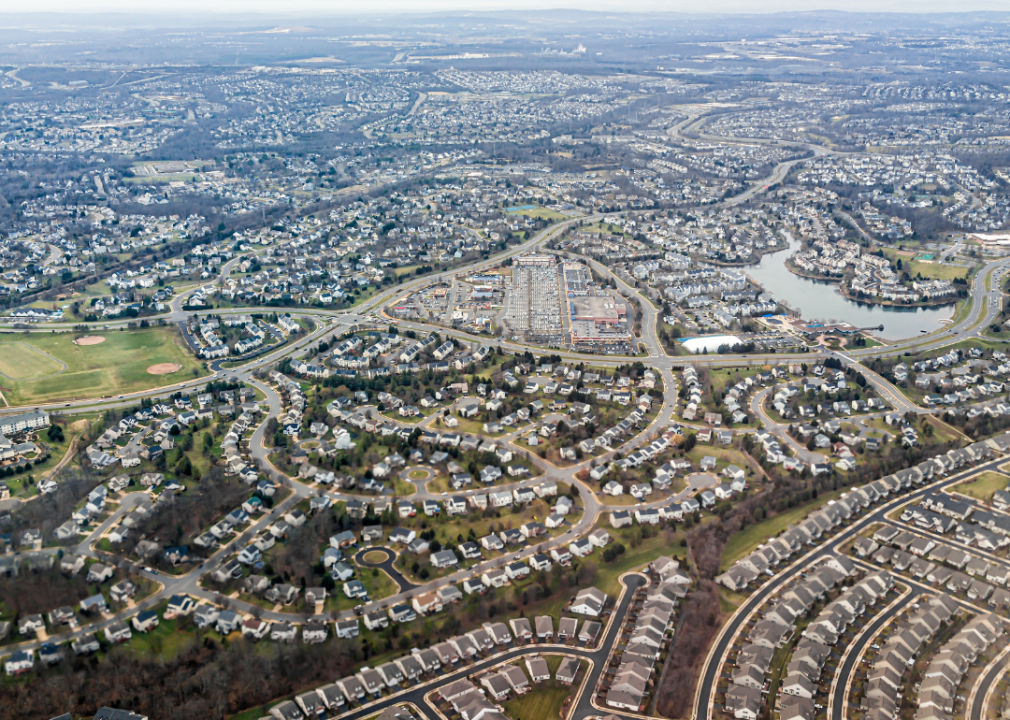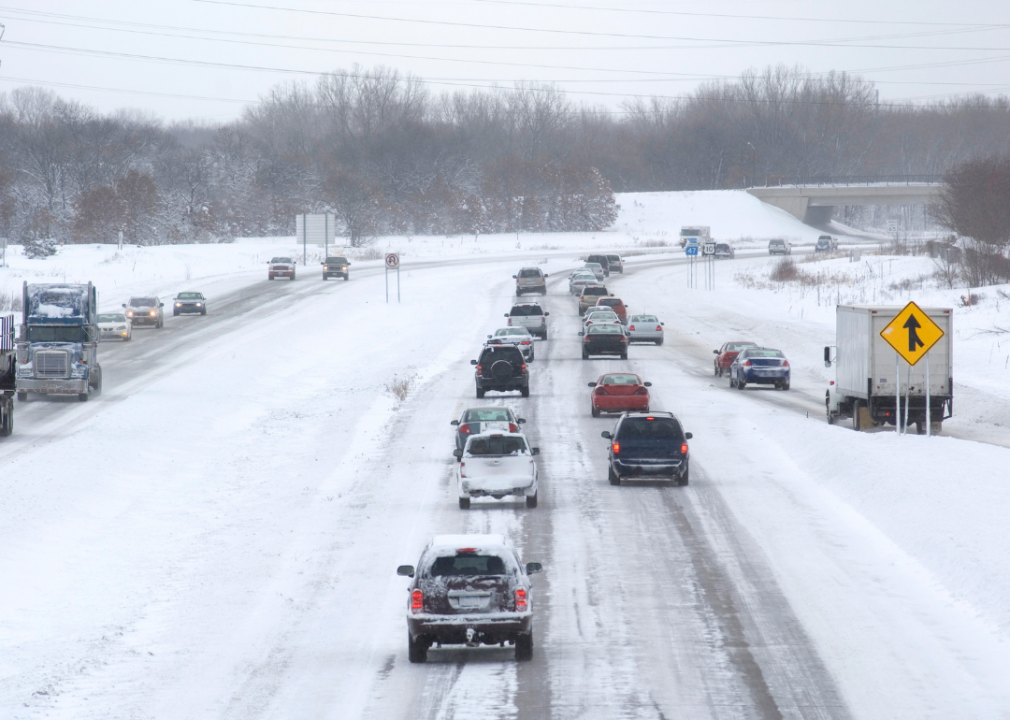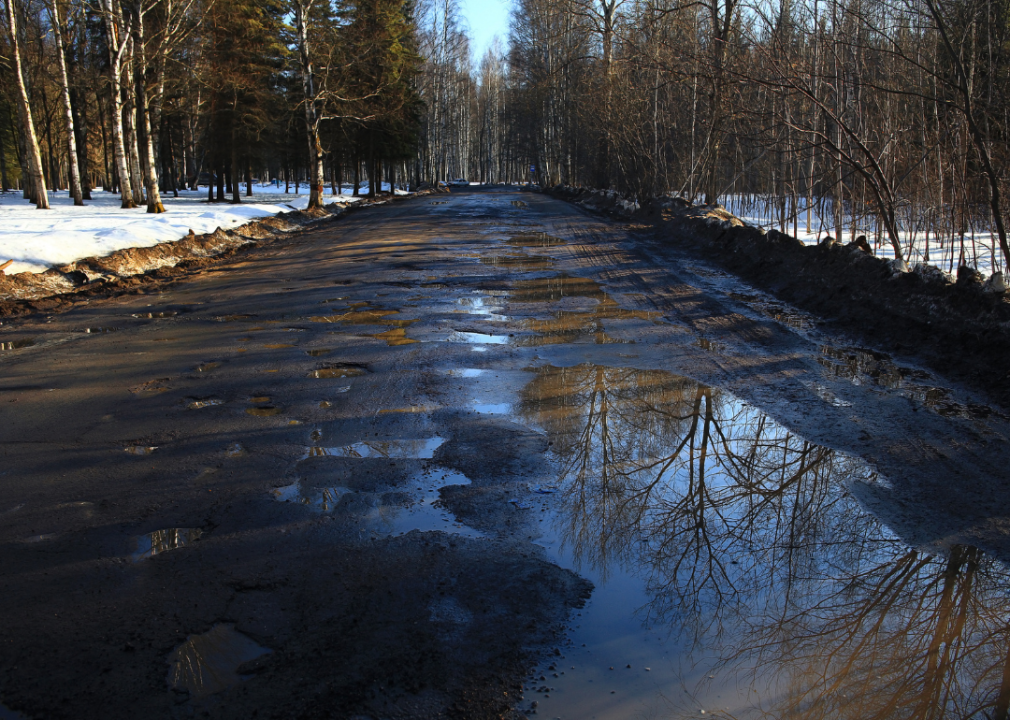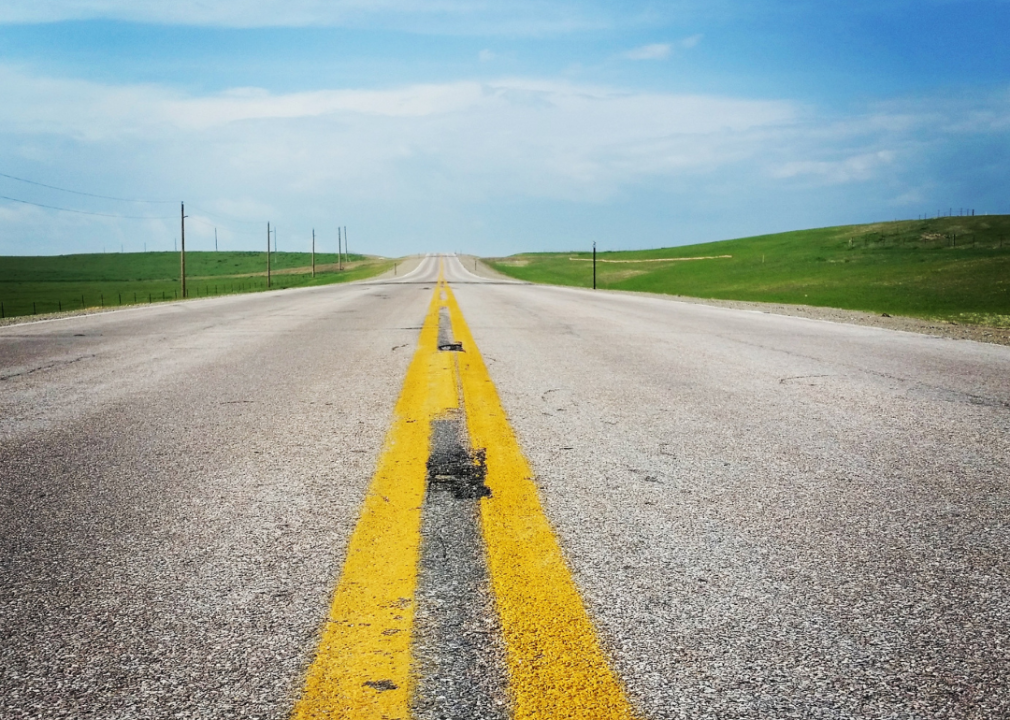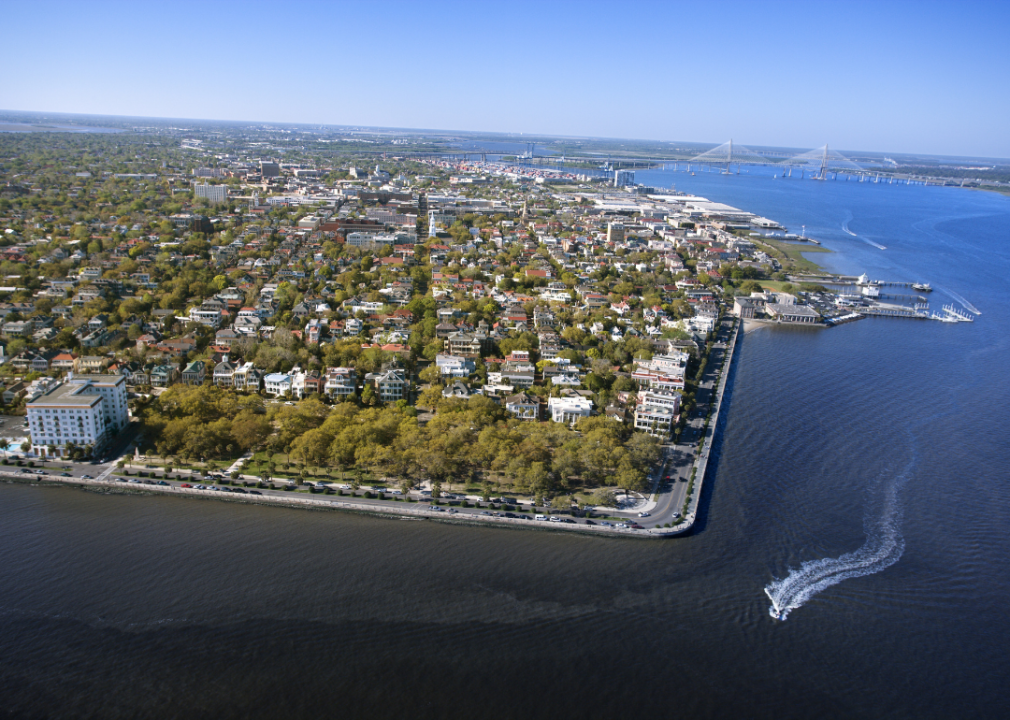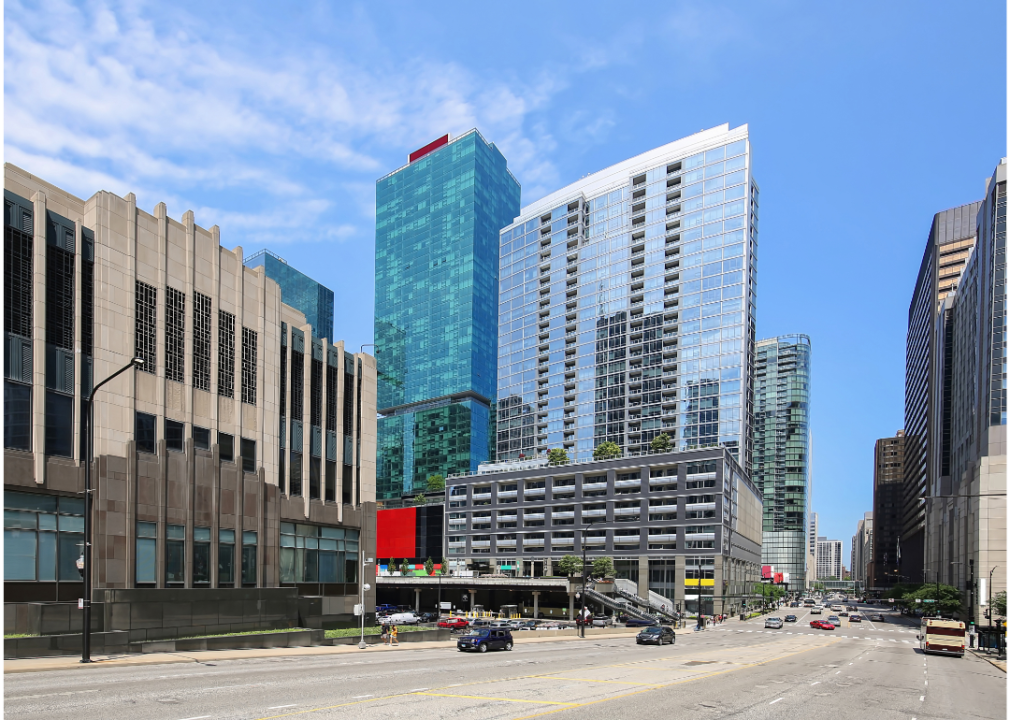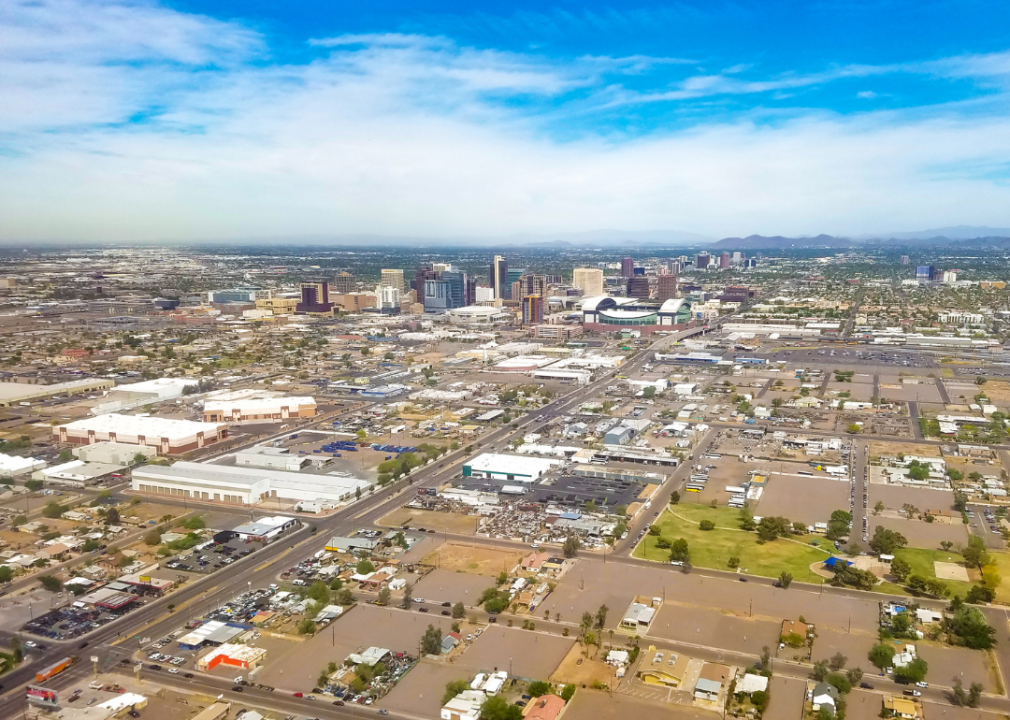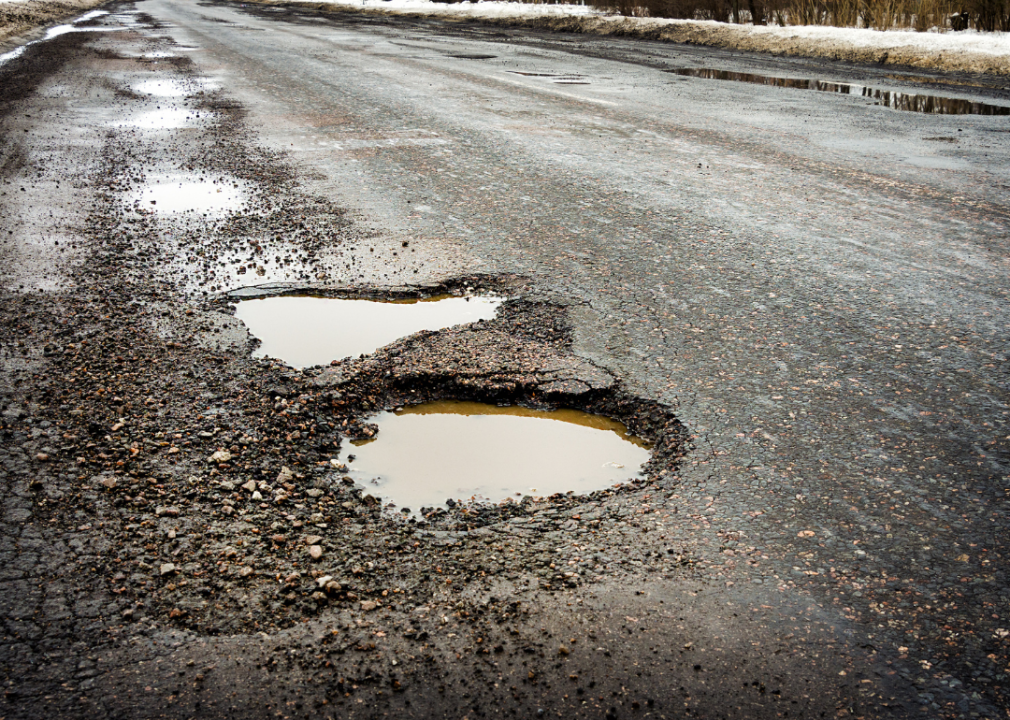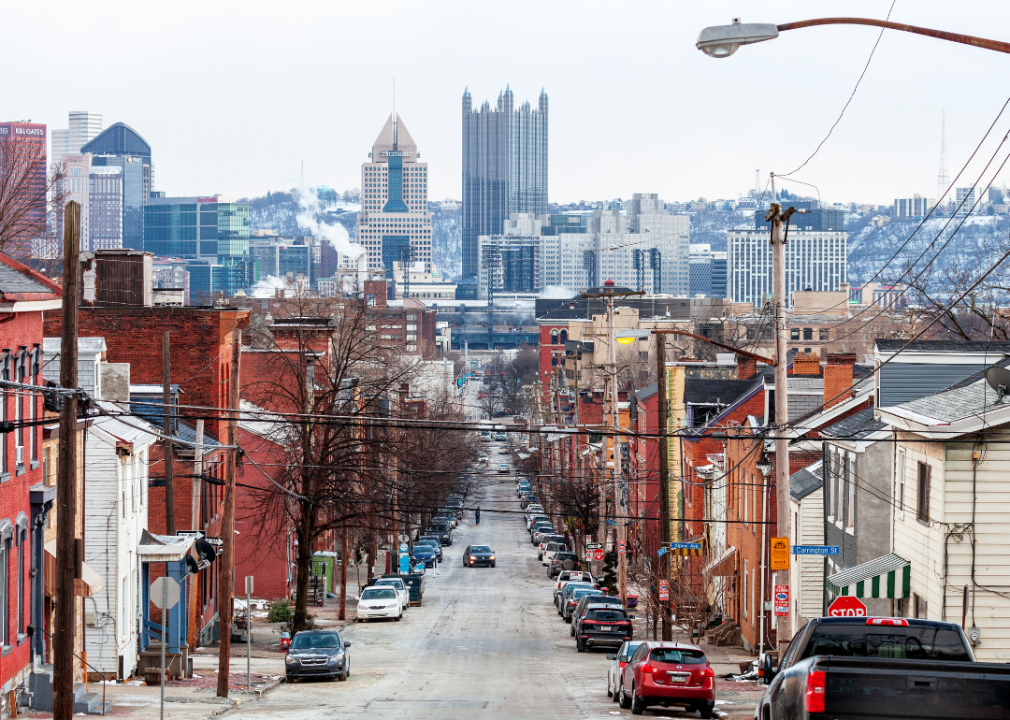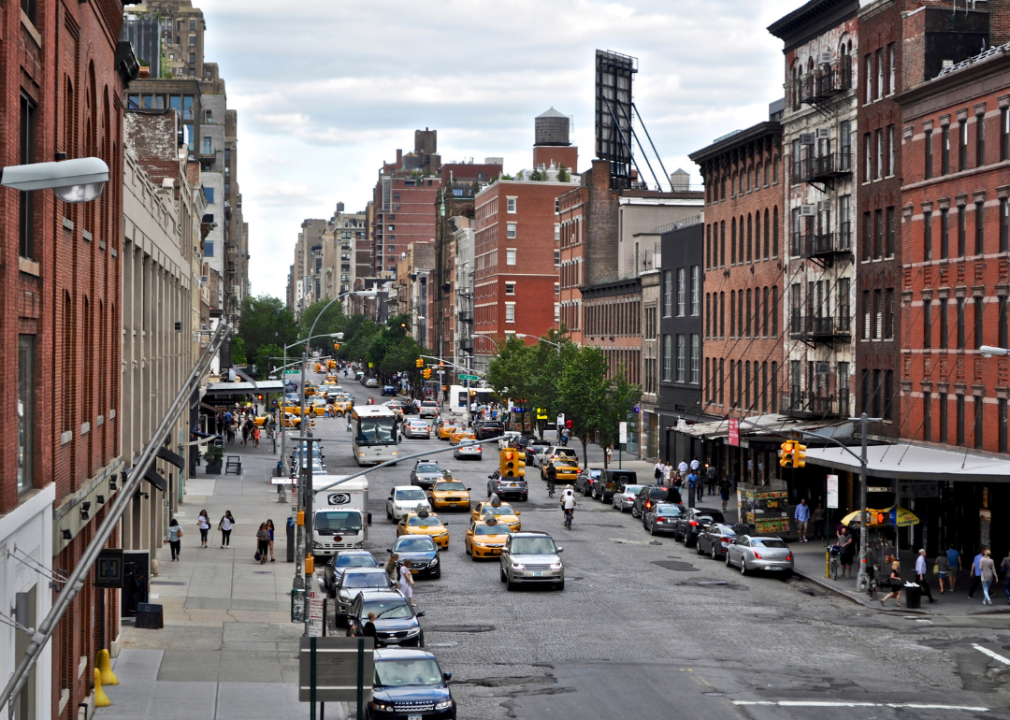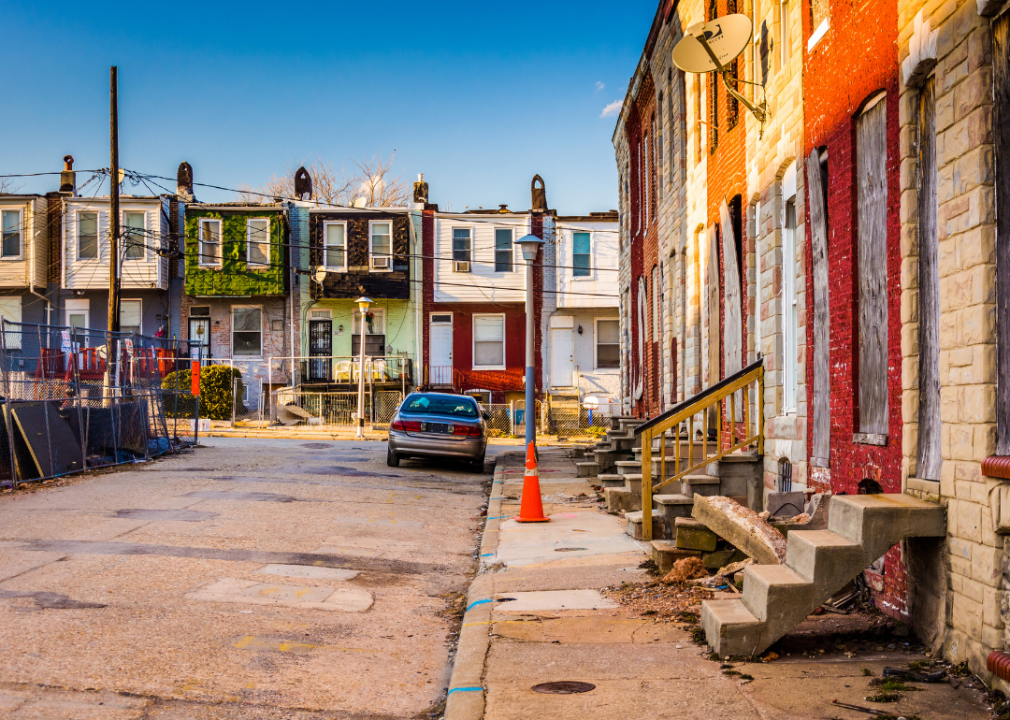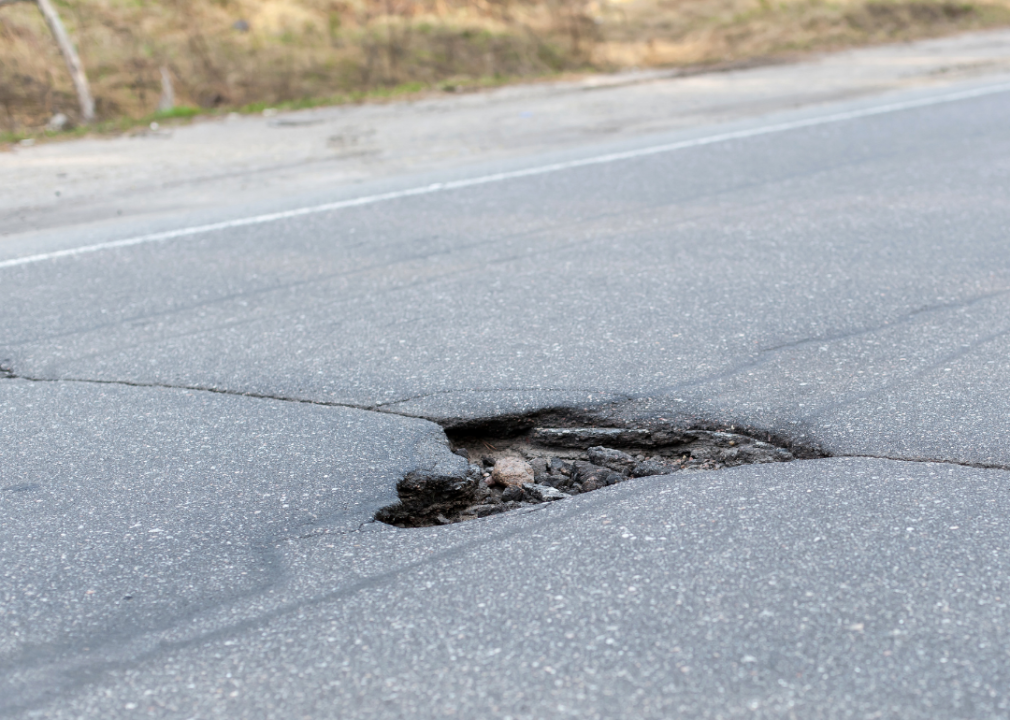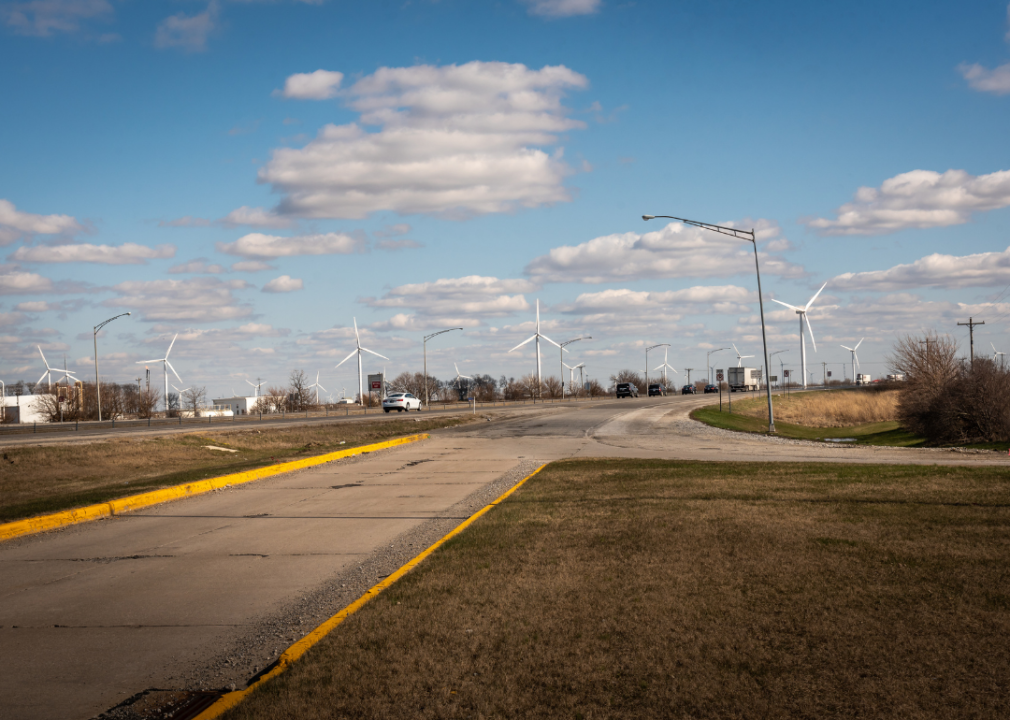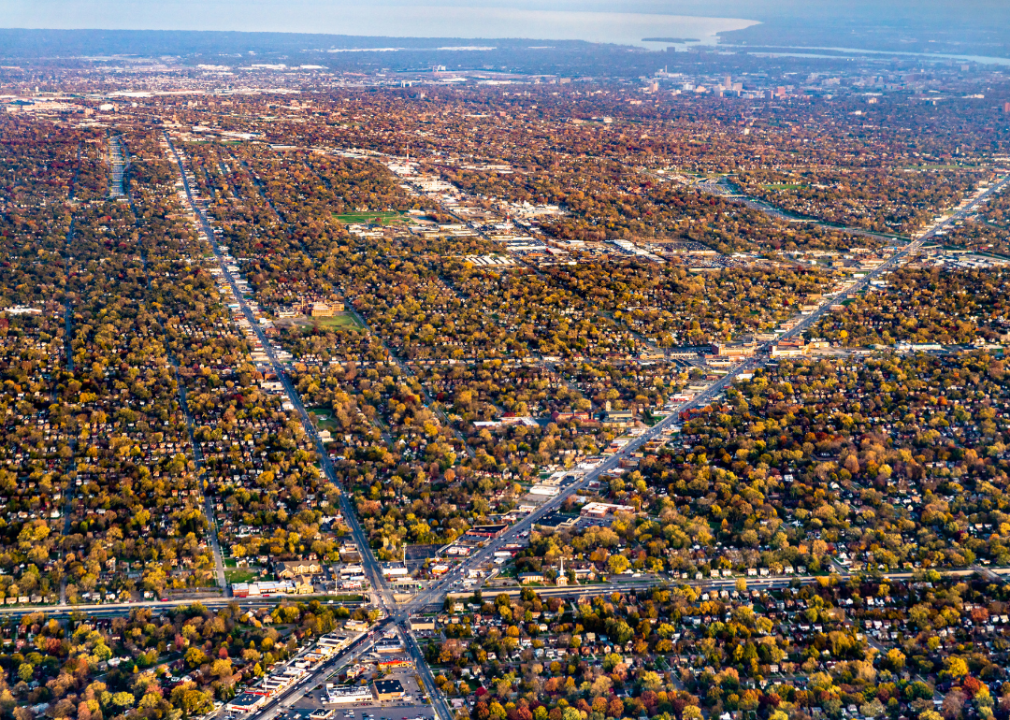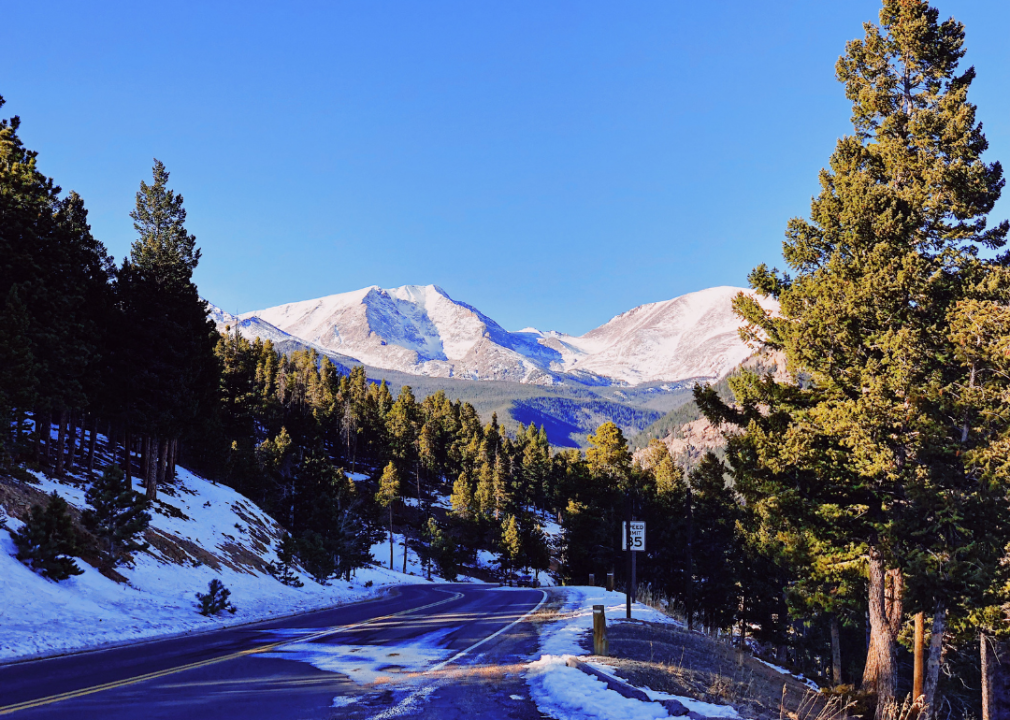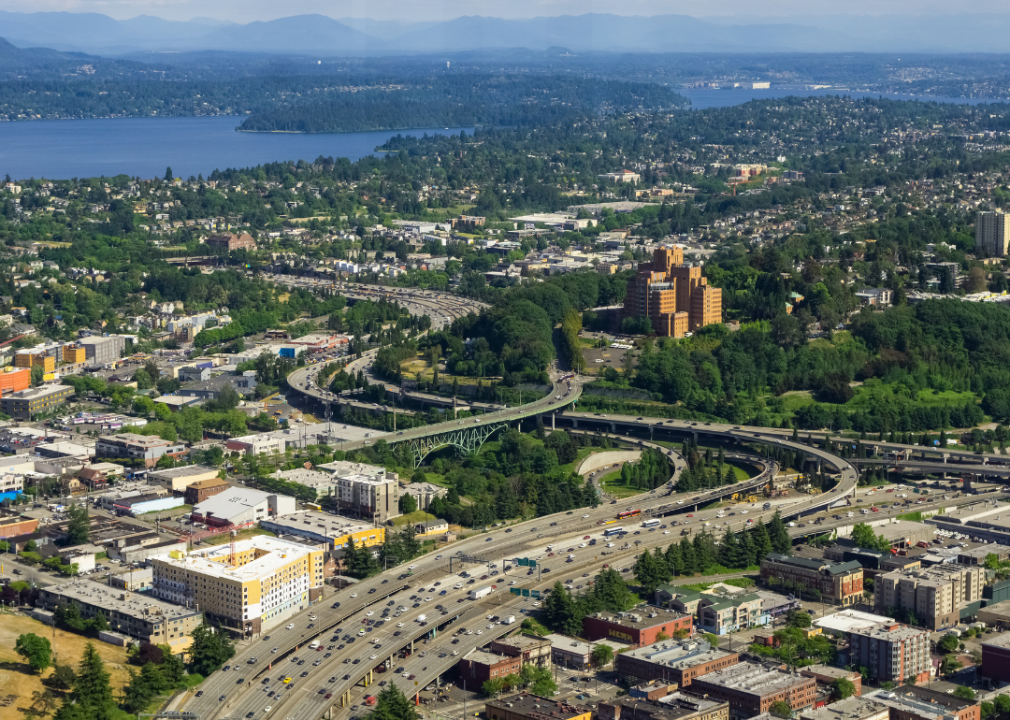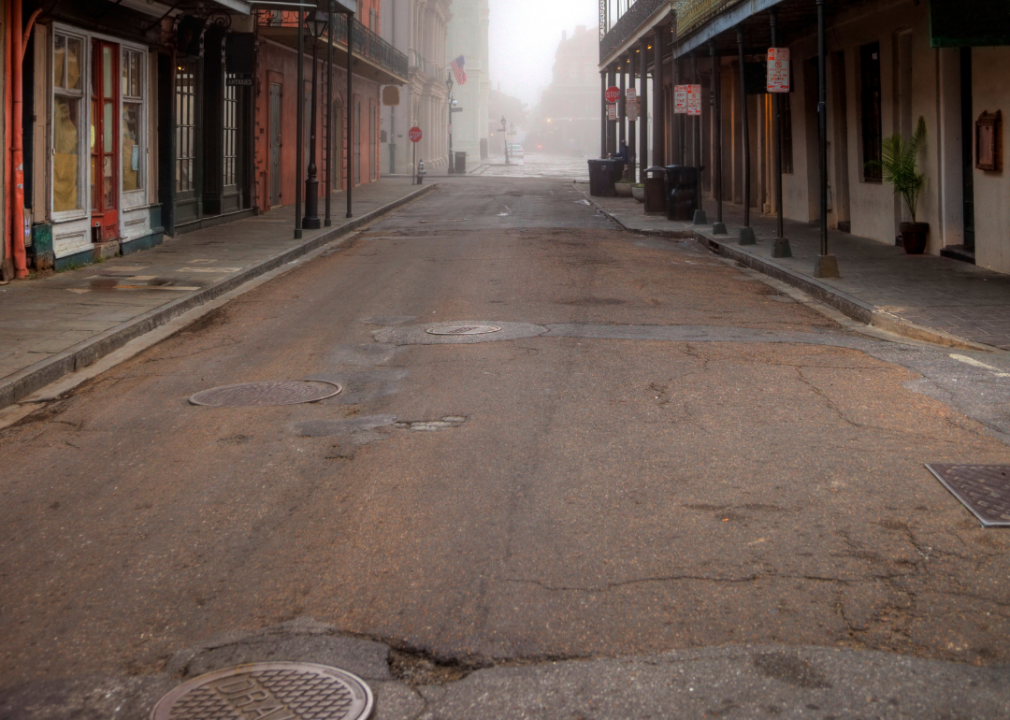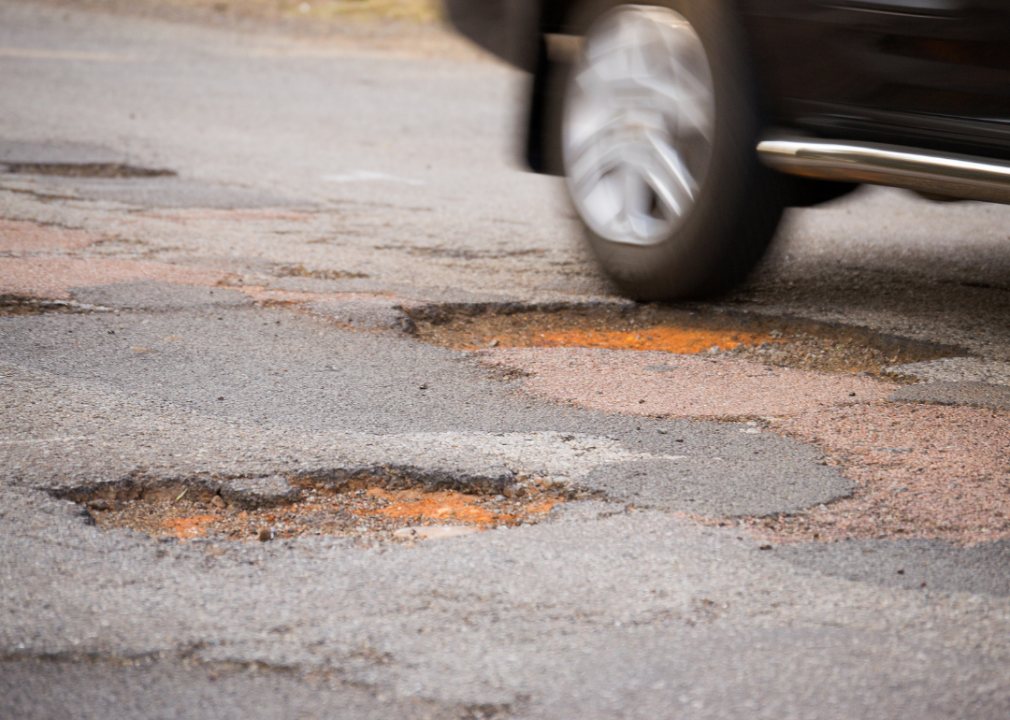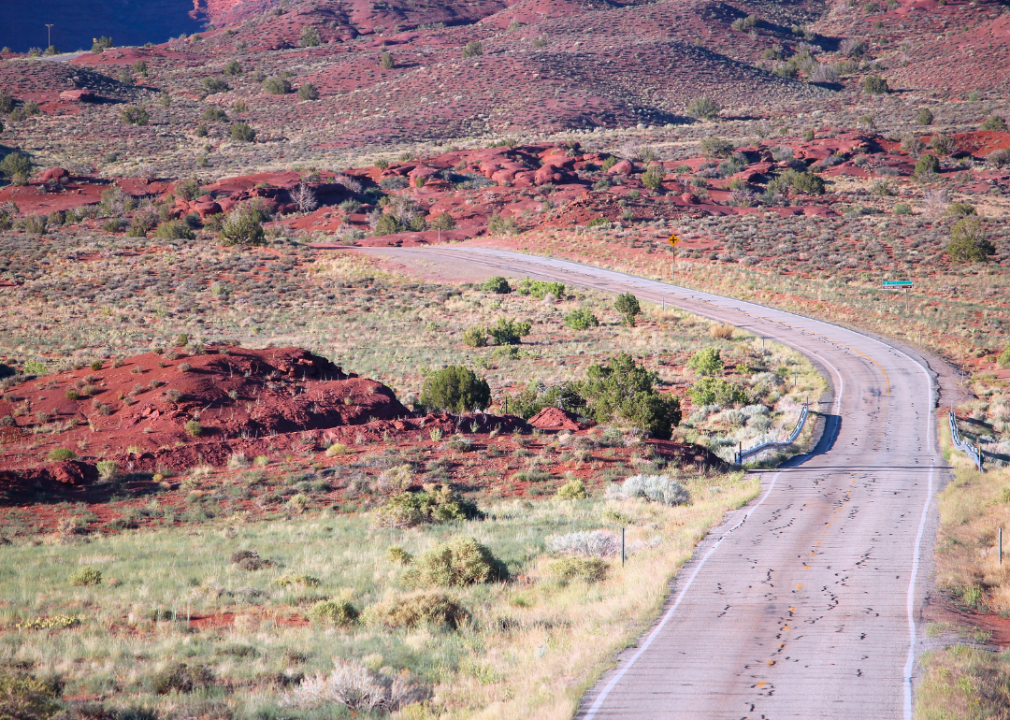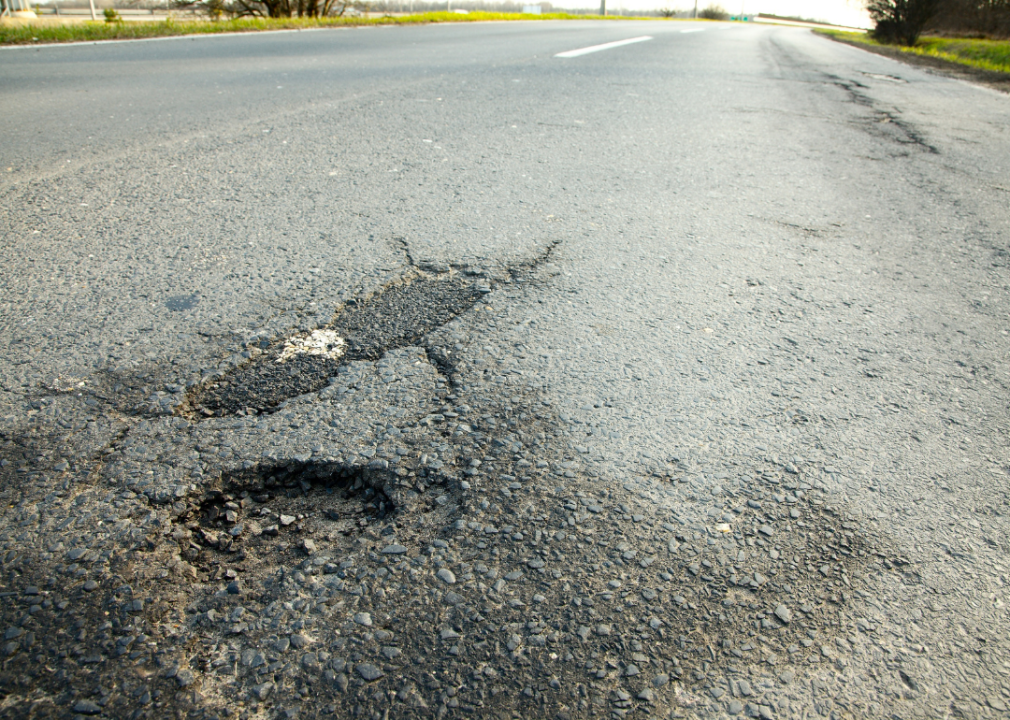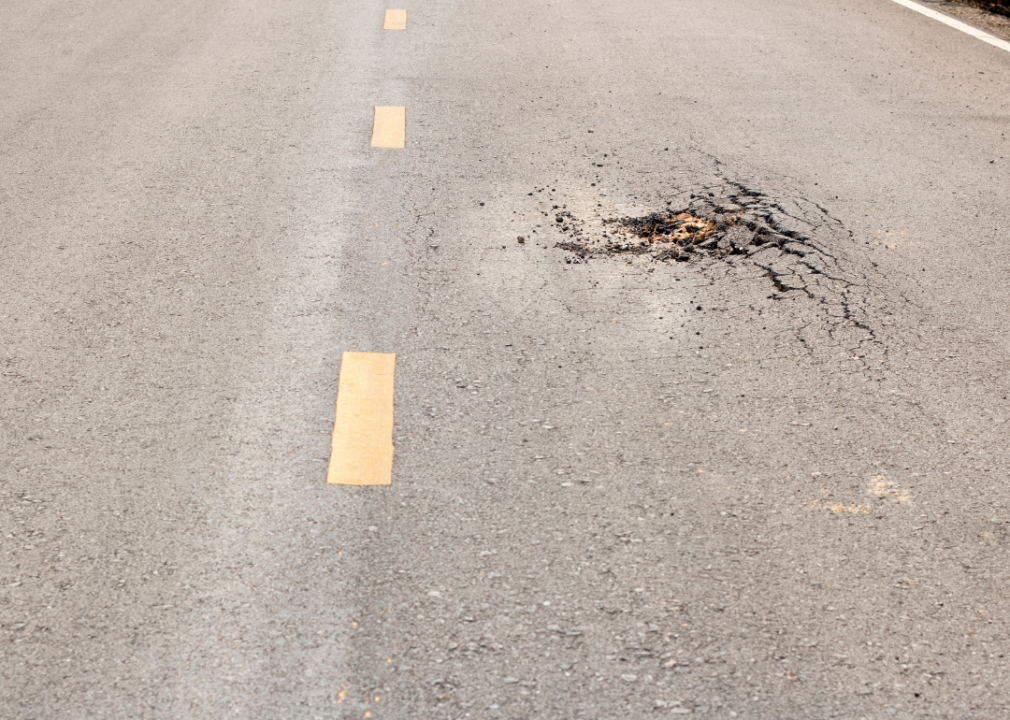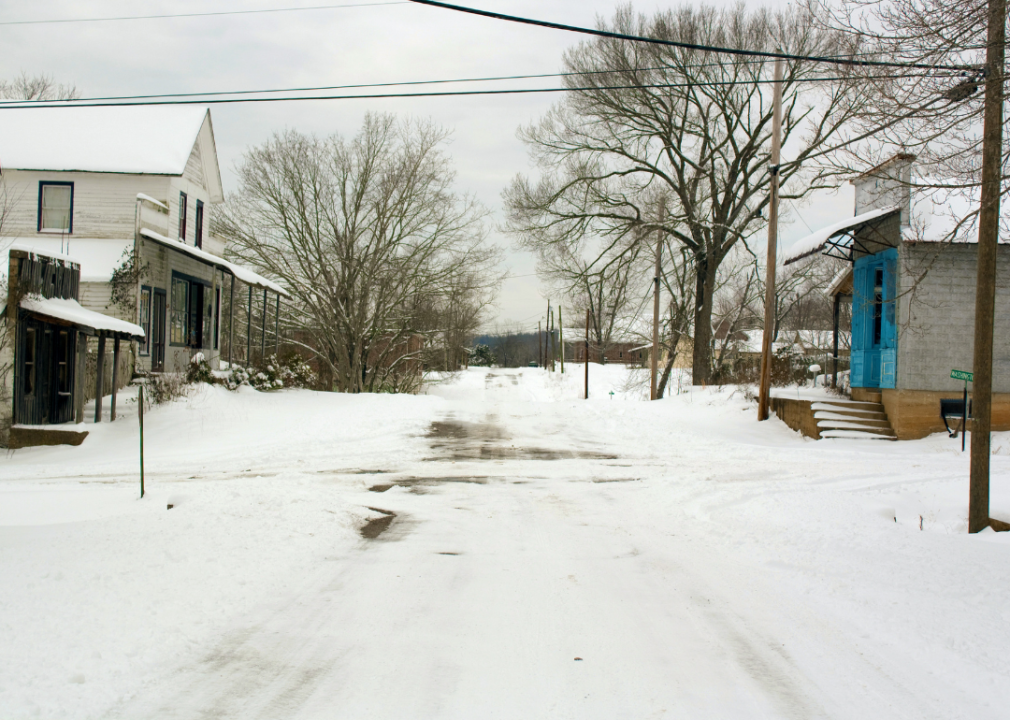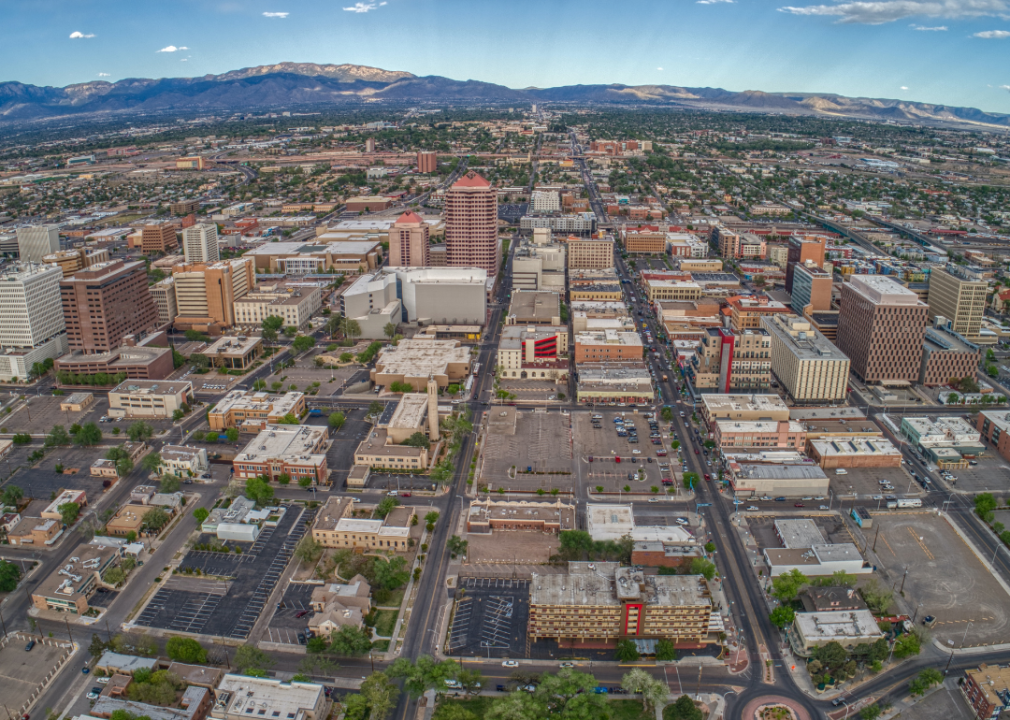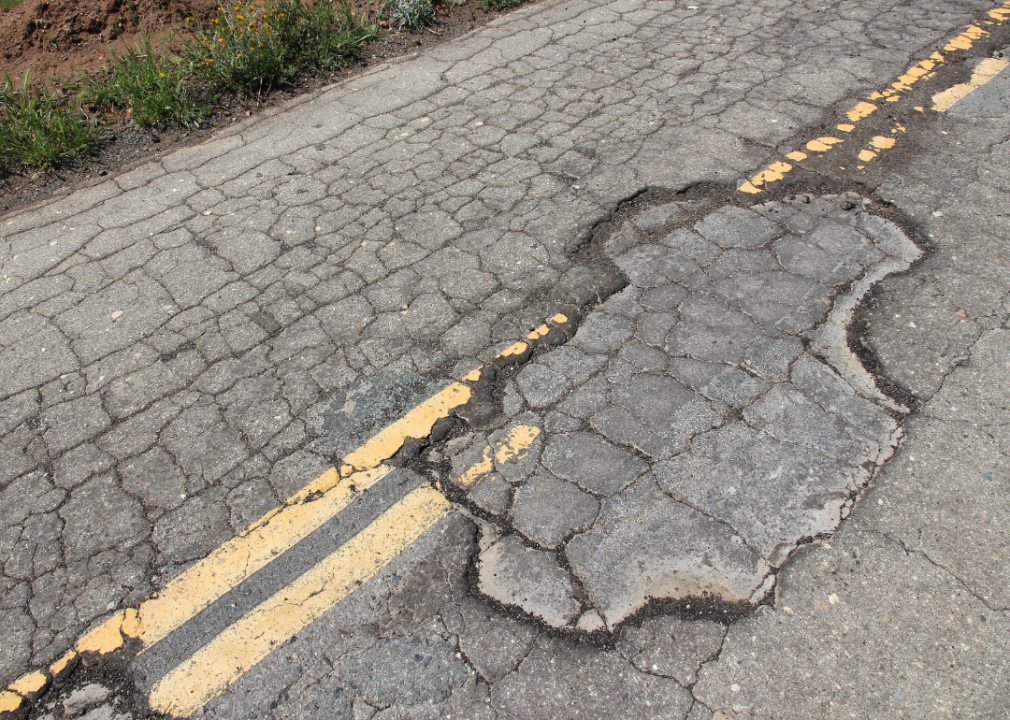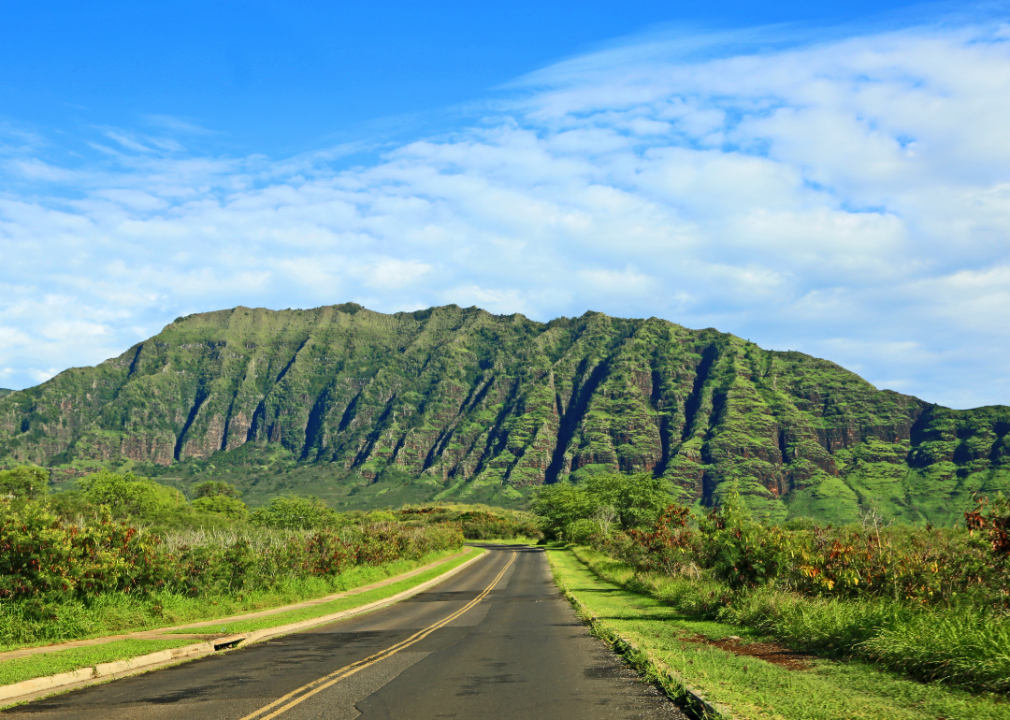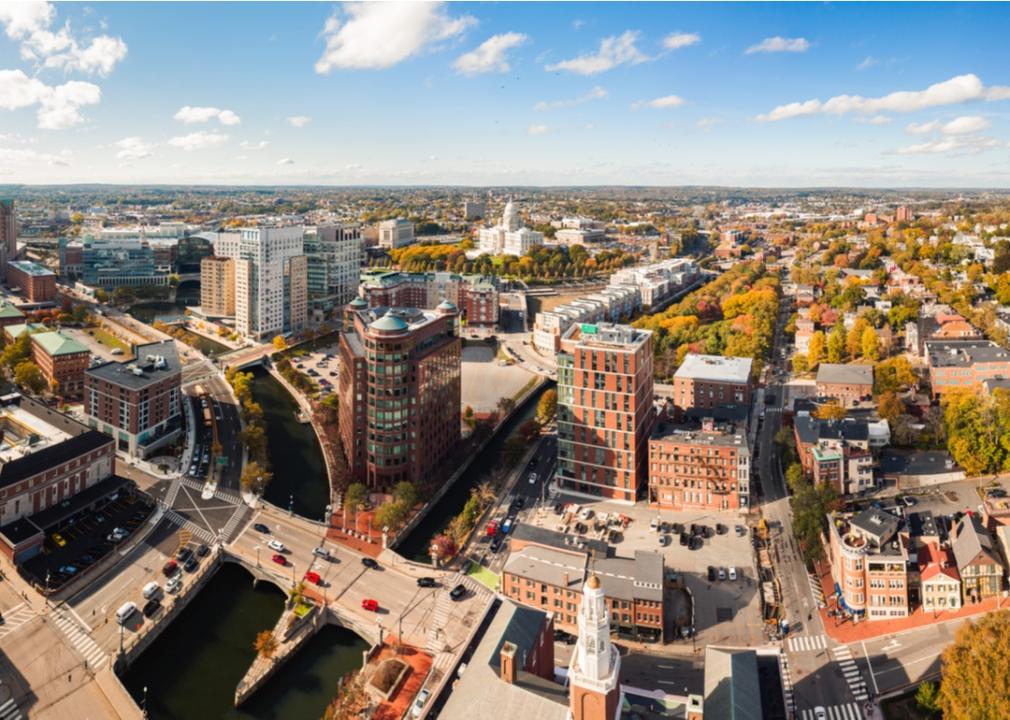What unmaintained roads cost the average driver in every state
Canva
What unmaintained roads cost the average driver in every state
In November 2021, President Joe Biden approved one of the largest federal infrastructure bills in history, spreading out $1.2 trillion across all 50 states and the District of Columbia. The Infrastructure Investment and Jobs Act is set to provide state governments with a much-needed boost in funding to be put toward updating roads, bridges, public transportation, and more. Among the other infrastructure priorities the bill will fund are the adoption of electric vehicles, widespread improvement to internet access, and enhancement for airports.
One of the most important, and most difficult to sustain, aspects of state-level infrastructure is the maintenance of roads and bridges. Traffic, freight, weather events, and, in many cases, snow and ice prevention all collide to cause road degradation that, in turn, transfers certain costs onto drivers in the form of car repair and maintenance and lost time in transit. Since federal funds are being allocated to states, many state governments are prioritizing state roads over local roads, which tend to fall under the purview of respective counties and cities, though some states are allocating money toward such localities to aid their individual infrastructure strategies.
RateGenius used data from state fact sheets released by the U.S. Department of Transportation to rank all states based on the cost of unmaintained roads to an average driver in each state. Bridge condition data was sourced from the Federal Highway Administration’s breakdown of the National Bridge Inventory as of September 2021, the most current data available.
The infrastructure report card grades come from the American Society of Civil Engineers (ASCE) and are calculated based on eight criteria, including capacity, condition, and public safety. Where this grade was not included in the fact sheets, the latest available grade was retrieved from the ASCE infrastructure report card website. The apportionment of expected funding for both highway programs and bridge replacement and repair projects reflects the total federal dollars to be received by each respective state through 2026.
![]()
Canva
#51. Tennessee
– Cost of unmaintained roads per person: $209
– Miles of road in poor condition: 270
– Bridges in poor condition: 841
– Infrastructure report card grade: C
– Expected funding for highway and bridge programs: $6.2 billion
Tennessee is currently in need of $62 billion in overall infrastructure support and repair, but the federal infrastructure bill will go a long way in helping the state improve. Tennessee will allocate $5.8 billion toward highway construction, $630 million toward public transportation improvements, and $302 million toward bridge repairs and replacements. A strong infrastructure will be important to Tennessee residents as many have suffered from flooding in areas like Waverly and wildfires across the state.
Canva
#50. Oregon
– Cost of unmaintained roads per person: $256
– Miles of road in poor condition: 1,287
– Bridges in poor condition: 382
– Infrastructure report card grade: C-
– Expected funding for highway and bridge programs: $3.7 billion
With funding from the $1.2 trillion federal bill, Oregon will be able to improve its road quality after receiving a low grade on its infrastructure report card. Of this funding, about $3.4 billion will be put toward the state’s highways and transit systems over the next five years. Some of the main focus points for the state include the Rose Quarter project in Portland, which will widen a stretch of Interstate 5, and the construction of an interstate crossing over the Columbia River.
Canva
#49. Wyoming
– Cost of unmaintained roads per person: $295
– Miles of road in poor condition: 380
– Bridges in poor condition: 230
– Infrastructure report card grade: C-
– Expected funding for highway and bridge programs: $2 billion
Wyoming plans to apportion $225 million of the $2 billion in federal funding it will receive to repair roughly 230 bridges that are considered to be in poor condition and another nearly 2,000 bridges in fair condition. The state is also proposing a fuel tax to provide further funds for the state’s infrastructure, which the Wyoming Department of Transportation claims it cannot keep up with due to a lack of money.
Canva
#48. Iowa
– Cost of unmaintained roads per person: $336
– Miles of road in poor condition: 403
– Bridges in poor condition: 4,504
– Infrastructure report card grade: C
– Expected funding for highway and bridge programs: $3.8 billion
Of Iowa’s 23,870 bridges, about 4,500 have been deemed “structurally deficient” by the Iowa Department of Transportation. Some of the most used bridges that are in poor condition are located in Polk County—the 2nd Avenue bridge over Birdland Drive and the southwest 9th Street bridge over Racoon River, with 18,600 and 17,600 daily crossings, respectively. With the $1.2 trillion federal bill, Iowa will devote $85 million annually over the next five years directly to its bridge repair and rehabilitation program.
Canva
#47. Georgia
– Cost of unmaintained roads per person: $375
– Miles of road in poor condition: 2,260
– Bridges in poor condition: 319
– Infrastructure report card grade: C+
– Expected funding for highway and bridge programs: $9.2 billion
Over the next five years, Georgia will use $225 million of its apportionment annually to repair its many bridges that are in disrepair, including the replacements of bridges in areas like Locust Grove where the population has grown 66% over the last 10 years. The money will go to Georgia’s 319 bridges in poor condition and over 3,600 bridges that are in fair condition. The state will also receive $8.9 billion to repair its roads and highways.
Canva
#46. Idaho
– Cost of unmaintained roads per person: $394
– Miles of road in poor condition: 1,102
– Bridges in poor condition: 238
– Infrastructure report card grade: C-
– Expected funding for highway and bridge programs: $2.2 billion
As part of the U.S. Department of Transportation’s Bridge Replacement, Rehabilitation, Preservation, Protection, and Construction program, Idaho will receive $225 million annually. This money will be allocated to fix the 238 bridges throughout the state judged to be in poor condition as well as the over 3,000 bridges that are in fair condition. Overall, however, the state is expected to get more than $2 billion to repair roads and bridges and another $192 million to expand public transportation.
Canva
#45. Oklahoma
– Cost of unmaintained roads per person: $394
– Miles of road in poor condition: 1,004
– Bridges in poor condition: 2,296
– Infrastructure report card grade: C-
– Expected funding for highway and bridge programs: $4.6 billion
Repairs to Oklahoma’s bridges are badly needed, and the state is going to devote $266.9 million each year to make those changes. The state has spent the last two decades working to make improvements to bridges after 11 people were killed when freight barges hit the Interstate 40 bridge over the Arkansas River, causing the structure to collapse. The state will also be given another $825 million to be allocated toward tribal transportation projects.
Canva
#44. Alaska
– Cost of unmaintained roads per person: $402
– Miles of road in poor condition: 570
– Bridges in poor condition: 134
– Infrastructure report card grade: C
– Expected funding for highway and bridge programs: $3.7 billion
Alaska expects to receive $3.4 billion in funding over five years from the federal government to not only maintain its roads but also build new ones. Of that, $225 million annually is expected to be allocated toward more than 130 bridges throughout the state that are in poor condition, among other projects. Some of the money, $75 million to be exact, will go to the Denali Commission, a group dedicated to developing infrastructure in rural Alaska where support is needed.
Canva
#43. North Dakota
– Cost of unmaintained roads per person: $410
– Miles of road in poor condition: 830
– Bridges in poor condition: 481
– Infrastructure report card grade: C-
– Expected funding for highway and bridge programs: $1.9 billion
Out of North Dakota’s 4,285 bridges, 11% are considered to be “structurally deficient,” ranking 42nd in the U.S. for bridge safety. The state’s urban roadways don’t fare much better in places like Fargo, the state’s largest city, where 26% of roads are badly in need of repair, as are 6% of bridges. To address these issues, the state will receive $1.9 billion in funding to go toward improving North Dakota’s roads and bridges with $225 million specifically allocated toward fixing bridges.
Canva
#42. Florida
– Cost of unmaintained roads per person: $425
– Miles of road in poor condition: 3,564
– Bridges in poor condition: 459
– Infrastructure report card grade: C
– Expected funding for highway and bridge programs: $13.3 billion
Since 2011, the commute time in Florida has increased by 11.6%, no thanks to the state’s waning roads. Throughout the state, there are more than 3,500 miles of road that are labeled as being in poor condition as well as 459 bridges, bringing to mind instances like the 2018 Florida International University bridge collapse which resulted in the death of six people. To address these issues, Florida is set to receive $13 billion toward fixing its crumbling and highly trafficked highways and roads.
Canva
#41. Alabama
– Cost of unmaintained roads per person: $434
– Miles of road in poor condition: 2,961
– Bridges in poor condition: 586
– Infrastructure report card grade: C-
– Expected funding for highway and bridge programs: $5.8 billion
In Alabama, drivers pay about $434 per person annually in road costs while the time it takes to commute for Alabamans has increased by 8.9% since 2011. The more populated cities like Birmingham have suffered infrastructure issues for years, such as cracks and potholes in the roads and sidewalks. Thanks to federal funding, Alabama will receive a 32.3% increase to its budget for maintaining its highways and bridges as well as $32 million to go toward reducing accidents and overall road safety.
Canva
#40. Kentucky
– Cost of unmaintained roads per person: $444
– Miles of road in poor condition: 1,322
– Bridges in poor condition: 990
– Infrastructure report card grade: C-
– Expected funding for highway and bridge programs: $5.1 billion
In the past decade, commute times in Kentucky have risen 6.3% while its road maintenance program has struggled to achieve a state of good repair. The federal bill will increase the state’s funding resources by 32.3% over its federal-aid highway formula funding under current law, while also providing $27 million per annum to build highway traffic safety programs.
Canva
#39. Delaware
– Cost of unmaintained roads per person: $456
– Miles of road in poor condition: 253
– Bridges in poor condition: 17
– Infrastructure report card grade: D
– Expected funding for highway and bridge programs: $1.4 billion
Along with West Virginia, Delaware received one of the worst grades when it comes to infrastructure, barely passing its report card. According to the Delaware News Journal, the focus of the state’s infrastructure headaches stems from more than 250 miles of highway that are in bad condition, increasing commute times by 5% since 2011. In January 2022, Gov. John Carney released his 2023 spending plan, which includes $1.2 billion toward federal highways, $225 million toward bridge repairs, and $220 million toward public transit.
Canva
#38. Nebraska
– Cost of unmaintained roads per person: $461
– Miles of road in poor condition: 1,125
– Bridges in poor condition: 1,280
– Infrastructure report card grade: C-
– Expected funding for highway and bridge programs: $2.2 billion
Nebraska will obtain $2.2 billion from the federal government to maintain its roads. In particular, the state plans to use funds to repair the 1,280 bridges in the state that are considered to be in poor condition. Among the projects already underway is the full reconstruction of an 8-mile stretch of Interstate 80 in the state’s panhandle.
Canva
#37. Montana
– Cost of unmaintained roads per person: $472
– Miles of road in poor condition: 1,485
– Bridges in poor condition: 365
– Infrastructure report card grade: C
– Expected funding for highway and bridge programs: $3.1 billion
Montana’s Democratic Sen. Jon Tester was one of the main advocates for the federal government’s massive infrastructure bill. His state has 365 bridges and nearly 1,500 miles of highway labeled poor by the U.S. Department of Transportation. Over the next five years, Montana expects to receive $3 billion toward its roads and highways, of which $225 million will be allocated toward maintaining and restoring bridges.
Canva
#36. New Hampshire
– Cost of unmaintained roads per person: $476
– Miles of road in poor condition: 698
– Bridges in poor condition: 194
– Infrastructure report card grade: C-
– Expected funding for highway and bridge programs: $1.4 billion
The state of New Hampshire has 194 bridges and about 700 miles of roads that are in need of repairs and replacements. The state is prone to rough winters, as well as issues with flooding and deep mud areas due to sudden thaw. New Hampshire is receiving $1.3 billion toward highway maintenance programs, of which $225 million will go toward bridge updates and $125 million to the expansion of public transportation.
Canva
#35. North Carolina
– Cost of unmaintained roads per person: $500
– Miles of road in poor condition: 3,116
– Bridges in poor condition: 1,325
– Infrastructure report card grade: C-
– Expected funding for highway and bridge programs: $7.7 billion
A lack of line visibility on highly trafficked roads such as Interstate 77 and Interstate 485 in North Carolina is making it increasingly more dangerous for North Carolina drivers, particularly in the rain. To fix this, the North Carolina Department of Transportation is allocating some of its federal funds toward a solution in 2023. In total, the state is receiving $7.7 billion for its roads for a period of five years, of which it will funnel $920 million toward its public transportation system and $457 million toward bridge maintenance.
Canva
#34. Ohio
– Cost of unmaintained roads per person: $506
– Miles of road in poor condition: 4,925
– Bridges in poor condition: 1,334
– Infrastructure report card grade: C-
– Expected funding for highway and bridge programs: $9.8 billion
The Brent Spence Bridge, one of the biggest bridges in the state and long overdue for repair, is just one of many that will benefit from federal funding; however, that isn’t the only investment Ohio plans to make. In Cleveland alone, the city is receiving $22 million to be used toward its public transit system, a critical investment for the state’s urban infrastructure. In total, Ohio is set to receive $9.2 billion for highway projects, $483 million for bridge repairs and replacements, and $1.2 billion to advance the state’s public transportation system.
Canva
#33. Kansas
– Cost of unmaintained roads per person: $509
– Miles of road in poor condition: 1,995
– Bridges in poor condition: 1,277
– Infrastructure report card grade: C
– Expected funding for highway and bridge programs: $2.8 billion
With its federal funding, the state of Kansas is looking to reduce the number of unpaved roads that make up 100 miles throughout the state. Bridge repairs will also be addressed—in the state capital, Topeka, alone, there are 59 bridges in need of repair. Among the biggest projects currently underway is the expansion of the I-70 Polk/Quincy Viaduct in Topeka, which has a price tag of just over $26 million.
Canva
#32. Vermont
– Cost of unmaintained roads per person: $517
– Miles of road in poor condition: 666
– Bridges in poor condition: 68
– Infrastructure report card grade: C
– Expected funding for highway and bridge programs: $1.6 billion
The Green Mountain State has one of the worst cities in America—Burlington—when it comes to potholes, which are a major contributor to the driver cost of poorly maintained roads. New funding will provide a welcome boost to Vermont’s road and bridge maintenance as, aside from normal wear-and-tear, the state also contends with natural disasters—for example, in the city of Waitsfield, a road was badly damaged by torrential rain that took weeks to repair.
Canva
#31. Virginia
– Cost of unmaintained roads per person: $517
– Miles of road in poor condition: 2,124
– Bridges in poor condition: 530
– Infrastructure report card grade: C-
– Expected funding for highway and bridge programs: $7.7 billion
In Virginia, repairs to roads such as Interstate 81, which stretches for roughly 325 miles across the state, have been long overdue. To address its 530 bridges and more than 2,000 miles of roads that are in poor condition, the state will receive $7.7 billion over the course of five years. This amount will include $43 million that will go toward highway safety measures.
Canva
#30. Maine
– Cost of unmaintained roads per person: $543
– Miles of road in poor condition: 1,438
– Bridges in poor condition: 314
– Infrastructure report card grade: C-
– Expected funding for highway and bridge programs: $1.5 billion
In Maine, the transportation department faces a backlog of projects from maintaining roads to repairing bridges. Described as a “once-in-a-generation investment” by the state’s governor, the state expects to receive $1.5 billion in funds for highways and bridges, and $234 million to improve its public transportation system. This money comes at a time when the state was struggling to keep up with increasing construction costs, which put pressure on a lot of infrastructure projects in areas like Portland.
Canva
#29. Minnesota
– Cost of unmaintained roads per person: $543
– Miles of road in poor condition: 4,986
– Bridges in poor condition: 618
– Infrastructure report card grade: C
– Expected funding for highway and bridge programs: $4.8 billion
The 2007 collapse of the Interstate 35W bridge in Minnesota taught the state a costly lesson in bridge maintenance after 13 people died and 145 others were injured. The state will receive $4.8 billion throughout the next five years from the federal government, $120 million of which will go toward fixing Minnesota’s more than 9,500 bridges in need of repair or updates. According to the Minnesota Department of Transportation, 35% of the bridges in the state are more than 50 years old and over 600 are labeled as being in poor condition.
Canva
#28. Wisconsin
– Cost of unmaintained roads per person: $547
– Miles of road in poor condition: 1,949
– Bridges in poor condition: 987
– Infrastructure report card grade: C
– Expected funding for highway and bridge programs: $5.4 billion
Wisconsin is no stranger to deteriorated roads and big-ticket rehabilitation projects alike. The $5.4 billion infusion the state will receive through 2026, will fund several large-scale projects across the state, among them the ongoing expansion and rebuild of Interstate 94 and a full reconstruction of Interstate 43 in the towns of Glendale and Grafton.
Canva
#27. Nevada
– Cost of unmaintained roads per person: $558
– Miles of road in poor condition: 1,090
– Bridges in poor condition: 29
– Infrastructure report card grade: C
– Expected funding for highway and bridge programs: $2.7 billion
When it comes to the money Nevada will receive from the federal infrastructure bill, enhancing and fixing roads as well as crosswalks is the priority. These funds will be used specifically at places like Faiss Middle School in Las Vegas where a 12-year-old boy was killed at a crosswalk in 2019. To combat Nevada’s increasing road fatalities, the Nevada Department of Transportation will receive $2.7 billion that will go toward road and bridge maintenance, including 2,100 bridges throughout the state that need repair, 29 of which are critical.
Canva
#26. South Dakota
– Cost of unmaintained roads per person: $562
– Miles of road in poor condition: 2,031
– Bridges in poor condition: 1,018
– Infrastructure report card grade: C-
– Expected funding for highway and bridge programs: $2.2 billion
With 17.3% of bridges in South Dakota classified as “structurally deficient,” the state has one of the worst issues with bridge conditions in the U.S., according to a report from the American Road and Transportation Builders Association. Some of the most traveled bridges that are in poor condition are located in Brown and Minnehaha Counties, with 19,426 and 18,174 daily crossings, respectively. The federal government is providing $1.9 billion to put toward road repairs and another $225 million to use for bridge maintenance over the next five years.
Canva
#25. South Carolina
– Cost of unmaintained roads per person: $564
– Miles of road in poor condition: 3,786
– Bridges in poor condition: 499
– Infrastructure report card grade: C-
– Expected funding for highway and bridge programs: $4.9 billion
While its infrastructure is aging, South Carolina’s population is growing. Most alarming, however, is that South Carolina’s roads have the highest fatality rates in the country, with 68% of the fatalities taking place in the state’s rural regions, according to the South Carolina Section of the American Society of Civil Engineers. The state estimates that its funding gap toward an overall state of good repair to all infrastructure assets will reach $43 billion in the next 20 years.
Canva
#24. Illinois
– Cost of unmaintained roads per person: $609
– Miles of road in poor condition: 6,218
– Bridges in poor condition: 2,405
– Infrastructure report card grade: C-
– Expected funding for highway and bridge programs: $11.2 billion
Illinois is getting one of the largest payouts from the Infrastructure Investment and Jobs Act. One of the largest issues the state has with its roads is potholes due to winter conditions along with the salt used to deice roads during and after winter storms. The state’s heavily trafficked roads don’t help either—many of which are in the Chicago area, where the conflation of Interstates 90, 94, 290, and 294 results in several hundred thousand vehicles per day.
Canva
#23. Arizona
– Cost of unmaintained roads per person: $614
– Miles of road in poor condition: 3,193
– Bridges in poor condition: 117
– Infrastructure report card grade: C
– Expected funding for highway and bridge programs: $5.3 billion
With an increase in population growth in recent years, Arizona residents have seen an 11% rise in commute times since 2011, with individual drivers paying about $614 annually in road costs. Public transportation, in particular, is an issue in the state with commuters spending an extra 90% of their time on or attempting to access transit systems. This has caused a race-based disparity, as non–white commuters are twice as likely to use public transportation systems. Arizona will receive $5.3 billion from the federal government to put toward maintaining its system, of which $225 million will go toward rehabilitating bridges and $884 million to improve its public transportation systems.
Canva
#22. Massachusetts
– Cost of unmaintained roads per person: $620
– Miles of road in poor condition: 1,194
– Bridges in poor condition: 456
– Infrastructure report card grade: C-
– Expected funding for highway and bridge programs: $5.3 billion
Due to a lack of resources, communities in western Massachusetts in particular are in need of infrastructure support with degrading roads and fading populations causing a dropoff of tax-based funding. Severe storms also contribute to these issues, creating extreme damage and wear-and-tear to the roads. Transportation research nonprofit TRIP puts Massachusetts as sixth in its list of states with congested urban interstates.
Canva
#21. Pennsylvania
– Cost of unmaintained roads per person: $620
– Miles of road in poor condition: 7,540
– Bridges in poor condition: 3,198
– Infrastructure report card grade: C-
– Expected funding for highway and bridge programs: $13 billion
With aging bridges in areas like Pike County, Pennsylvania’s bridges are in dire need of repair. Most ironically, however, was when a Pittsburgh bridge collapsed, injuring 10 people, the same day President Biden was set to visit the city and give a speech on his $1.2 trillion infrastructure bill. Pennsylvania is receiving one of the largest financial packages to fix its roads and bridges—as well as $2.8 billion for its public transit system.
Canva
#20. New York
– Cost of unmaintained roads per person: $625
– Miles of road in poor condition: 7,292
– Bridges in poor condition: 1,672
– Infrastructure report card grade: C-
– Expected funding for highway and bridge programs: $13.5 billion
Of the 17,555 bridges in New York, nearly 10% are in poor shape, while 27% of roads are labeled as the same, according to the state’s Infrastructure Report Card for America’s Infrastructure. In particular, New York is in desperate need of repairs to its rail tunnels that run under the Hudson River, which connect New York City to New Jersey. According to Bloomberg, New York City’s Metropolitan Transit Authority is “running on borrowed time.” To combat this issue, the state is receiving $9.8 billion for public transit system improvements.
Canva
#19. Maryland
– Cost of unmaintained roads per person: $637
– Miles of road in poor condition: 2,201
– Bridges in poor condition: 253
– Infrastructure report card grade: C
– Expected funding for highway and bridge programs: $4.6 billion
Baltimore, the largest city in Maryland, is long overdue for a public transportation overhaul, and the state overall is in need of updates to its roads as a result of heavy traffic and many roads outliving their design life. In particular, there is a need to replace Amtrak’s Baltimore and Potomac Tunnel and to make updates to the city’s East-West Priority Corridor. The $4.6 billion Maryland is set to receive over the next five years is a nearly 36% boost over its federal aid highway funding.
Canva
#18. Mississippi
– Cost of unmaintained roads per person: $637
– Miles of road in poor condition: 5,840
– Bridges in poor condition: 1,174
– Infrastructure report card grade: D+
– Expected funding for highway and bridge programs: $3.6 billion
Mississippi has long since needed updates to its infrastructure, especially in the city of Jackson, which has captured national headlines with its water crisis. In fact, the state has one of the lowest scores in the whole country when it comes to infrastructure, with Mississippi’s driver fatality rate among the highest in the U.S. Still, Mississippi is eligible to compete for $15 billion in additional federal dollars for megaprojects that directly impact communities in need, a potential boon to a state with a 21.5% poverty rate.
Canva
#17. Indiana
– Cost of unmaintained roads per person: $638
– Miles of road in poor condition: 5,478
– Bridges in poor condition: 1,082
– Infrastructure report card grade: C-
– Expected funding for highway and bridge programs: $7.0 billion
Multiple bridges in the Hoosier State have been closed due to disrepair, including the New Harmony Toll Bridge—which connects Indiana to Illinois—and the historic Spencerville Covered Bridge, which was opened back up in June 2021 after being closed since 2018. Aging roads are also a big concern for Indiana residents as nearly a quarter of the state’s roads are in poor condition, costing drivers $638 annually. In response to such conditions and in light of the federal infrastructure bill, the Indiana Department of Transportation has updated its five-year plan for road projects.
Canva
#16. Michigan
– Cost of unmaintained roads per person: $644
– Miles of road in poor condition: 7,300
– Bridges in poor condition: 1,240
– Infrastructure report card grade: D+
– Expected funding for highway and bridge programs: $7.8 billion
Michigan’s old roadways are taking a heavy toll on its economy with potholes, sinkholes, and structurally deficient bridges. In fact, 11% of the state’s bridges are in poor condition with some bridges in Oakland and Wayne Counties receiving 100,000 to over 200,000 daily commuters. As a result of the Infrastructure Investment and Jobs Act, Michigan Gov. Gretchen Whitmer has created a special office to direct funding to respective projects and initiatives.
Canva
#15. Colorado
– Cost of unmaintained roads per person: $651
– Miles of road in poor condition: 3,620
– Bridges in poor condition: 469
– Infrastructure report card grade: C-
– Expected funding for highway and bridge programs: $4.0 billion
From hail to wildfires, Colorado is a state with an infrastructure that suffers from its extreme climate and weather conditions. Colorado has many steep and dangerous mountain roads, such as Wolf Creek Pass in the San Juan Mountains, that are difficult to maintain. Among the most significant ongoing road and bridge projects is the North I-25 Express Lanes project, which will widen 18 miles of interstate, just as the recently completed I-25 South Gap project did.
Canva
#14. Washington
– Cost of unmaintained roads per person: $659
– Miles of road in poor condition: 5,469
– Bridges in poor condition: 401
– Infrastructure report card grade: C
– Expected funding for highway and bridge programs: $5.3 billion
In Washington’s Puget Sound area, population growth is expanding at a rapid rate, hiking up the state’s commute time by 12.7% since 2011. Nearly 5% of the state’s bridges are in dire need of repair, with one bridge in particular in King County, the SW Spokane Street bridge, experiencing daily crossings of 108,179. Among the Puget Sound’s other major projects is the Highway 520 Bridge, which provides a crucial link to communities in the greater Seattle area.
Canva
#13. Louisiana
– Cost of unmaintained roads per person: $667
– Miles of road in poor condition: 3,411
– Bridges in poor condition: 1,631
– Infrastructure report card grade: D+
– Expected funding for highway and bridge programs: $5.9 billion
Louisiana ranks #7 when it comes to structurally deficient bridges with nearly 13% of its bridges in poor condition. The Calcasieu River Bridge in Calcasieu County and the Interstate 20 bridge in Caddo County are among the most traveled bridges in disrepair with 86,600 and 84,672 daily crossings, respectively. Louisiana is also the most flood-prone state, which presents further danger to its roads and bridges. In addition to the federal dollars the state will receive, the U.S. Army Corps of Engineers will work on a $6 billion project to build flood defense systems across the state.
Canva
#12. Arkansas
– Cost of unmaintained roads per person: $671
– Miles of road in poor condition: 6,711
– Bridges in poor condition: 679
– Infrastructure report card grade: D+
– Expected funding for highway and bridge programs: $3.8 billion
Arkansas roads are in particular need of maintenance as 31% are considered to be in poor condition, according to the 2021 Report Card for America’s Infrastructure. Bridges are in need of repair as well; for example, in June 2021 a crack was found in the Interstate-40 Hernando DeSoto Bridge that links Arkansas and Tennessee. Arkansas plans to attack its crumbling roads via its Connecting Arkansas Program, which is the largest such program in the state’s history.
Canva
#11. Texas
– Cost of unmaintained roads per person: $709
– Miles of road in poor condition: 19,441
– Bridges in poor condition: 789
– Infrastructure report card grade: C
– Expected funding for highway and bridge programs: $27.4 billion
With an infrastructure not built to withstand frigid weather, Texas has been the subject of national headlines in recent years, particularly after a massive winter storm knocked power out across the state and caused the death of at least 246 people. The Lone Star State also has the largest network of bridges in the U.S. with only 1.4% considered to be in poor condition; however, three bridges in Harris County that are structurally deficient have well over 100,000 crossings per day. Texas also has thousands of oil and gas wells across the state, which produces a terrific amount of heavy truck and freight traffic, and has been a major contributor to the condition of its roads.
Canva
#10. Utah
– Cost of unmaintained roads per person: $709
– Miles of road in poor condition: 2,064
– Bridges in poor condition: 63
– Infrastructure report card grade: C+
– Expected funding for highway and bridge programs: $2.6 billion
While the state of Utah received the best overall grade when it came to its infrastructure, there are still many pressing repairs and updates that are needed throughout the state. For example, nearly 1 in 3 bridges in the state have surpassed their 50-year lifespan, according to Utah’s Infrastructure Report Card. This past year, Utah experienced the highest number of road fatalities since 2002, despite a significant dropoff in vehicle miles traveled due to the pandemic, so the additional $19 million for road traffic safety programs will hopefully go a long way toward curbing that figure.
Canva
#9. Connecticut
– Cost of unmaintained roads per person: $711
– Miles of road in poor condition: 2,154
– Bridges in poor condition: 231
– Infrastructure report card grade: C-
– Expected funding for highway and bridge programs: $4.0 billion
About 34% of Connecticut roads are considered to be in disrepair, according to the Report Card for America’s Infrastructure, with drivers paying $711 a year as a result. As for the state’s bridges, the Interstate 95 bridge in New Haven County as well as two Fairfield County bridges have more than 120,000 daily crossings—problematic, as all three bridges are considered to be in poor condition. Fortunately, Connecticut will receive more than $560 million from the federal government to improve its bridges and further bankroll its Local Bridge Program.
Canva
#8. New Jersey
– Cost of unmaintained roads per person: $713
– Miles of road in poor condition: 3,995
– Bridges in poor condition: 482
– Infrastructure report card grade: D+
– Expected funding for highway and bridge programs: $8 billion
Over a third of New Jersey’s roads are in need of repair, 37% to be exact, increasing commute times by 8.8% since 2011. In particular, Route 22 that stretches through Union and Springfield, and Routes 9 and 35 that run through South Amboy are some of the state’s worst roads, heavily trafficked and dangerous. New Jersey will receive $6.8 billion to fix its aging roads, $1.2 billion to replace its bridges, and another $4.1 billion to make improvements to its public transportation system.
Canva
#7. West Virginia
– Cost of unmaintained roads per person: $726
– Miles of road in poor condition: 3,222
– Bridges in poor condition: 1,490
– Infrastructure report card grade: D
– Expected funding for highway and bridge programs: $3.7 billion
West Virginia received one of the lowest grades when it came to its infrastructure report card, along with Delaware. More than 20% of the state’s bridges are labeled structurally deficient, making it #1 in the nation for bridges in poor condition. Coal and gas sourcing has taken its toll on the state’s roadways; a program to use gasoline taxes toward infrastructure programs remains mired in political turmoil.
Canva
#6. Missouri
– Cost of unmaintained roads per person: $743
– Miles of road in poor condition: 7,576
– Bridges in poor condition: 2,218
– Infrastructure report card grade: C-
– Expected funding for highway and bridge programs: $7.0 billion
About 9% of Missouri’s bridges are in disrepair, making it #5 in the U.S. when it comes to the number of structurally deficient bridges. Some of the most highly traveled bridges in poor condition are located in St. Louis County where hundreds of thousands of motorists cross every day, especially on Interstate 270. The Missouri Department of Transportation is presently mired in a lawsuit over whether it is empowered to have full discretion over the distribution of the state’s road fund. Fortunately, the administration of the federal infrastructure funds will not be affected.
Canva
#5. New Mexico
– Cost of unmaintained roads per person: $767
– Miles of road in poor condition: 3,822
– Bridges in poor condition: 208
– Infrastructure report card grade: C-
– Expected funding for highway and bridge programs: $2.8 billion
About a third of New Mexico’s roads are in poor condition, according to the 2021 Report Card for America’s Infrastructure, with Interstate 40 considered to be one of the most dangerous. Of its structurally deficient bridges, totally 5.2% statewide, many of the most highly trafficked can be found in Bernalillo and Santa Fe counties, which are two of the state’s three most populous regions. The New Mexico DOT has been making progress on its poor bridge inventory, recently celebrating the opening of the $34 million I-25 University Avenue Project in Las Cruces.
Canva
#4. California
– Cost of unmaintained roads per person: $799
– Miles of road in poor condition: 14,200
– Bridges in poor condition: 1,493
– Infrastructure report card grade: C-
– Expected funding for highway and bridge programs: $29.5 billion
Some of California’s most traveled bridges, including ones on Interstate 5 in San Diego, Highway 101 in Los Angeles, and Interstate 80 in Sacramento, are badly in need of rehabilitation. In total, nearly 6% of the Golden State’s bridges are in poor condition, which is an increase from 2017 numbers. To address its infrastructure issues, California will receive the largest parcel of infrastructure funding over the next five years, which is also one of the five largest in terms of per capita allowance. It will go to good use as the state has several megaprojects currently underway, including the Los Angeles to San Francisco high-speed rail line, which just keeps getting pricier.
Canva
#3. Hawaii
– Cost of unmaintained roads per person: $818
– Miles of road in poor condition: 664
– Bridges in poor condition: 87
– Infrastructure report card grade: D+
– Expected funding for highway and bridge programs: $1.5 billion
Hawaii’s isolation as an island and limited amount of land has presented many challenges to its infrastructure, particularly to its roadways. Nonetheless, the state is taking action in the form of a Climate Adaptation Action Plan and has in recent years progressed on several major projects including a rail system in Honolulu and improvements to Pali Highway following a damaging mudslide. Still, the Hawaii Department of Transportation will need every dime of federal money coming its way—Consumer Affairs recently found it to have the second worst roads in the U.S.
Big Joe // Shutterstock
#2. Rhode Island
– Cost of unmaintained roads per person: $845
– Miles of road in poor condition: 860
– Bridges in poor condition: 136
– Infrastructure report card grade: C-
– Expected funding for highway and bridge programs: $1.7 billion
Rhode Island has one of the worst issues with bridges in the country with nearly 18% classified as being in poor condition by the American Road and Transportation Builders Association. An example of some of the worst issues the state faces can be found in the Washington Bridge, though a project was underway as of October 2021 to replace the failing bridge. Consumer Affairs ranked Rhode Island as absolute worst in road quality—and its drivers agree.
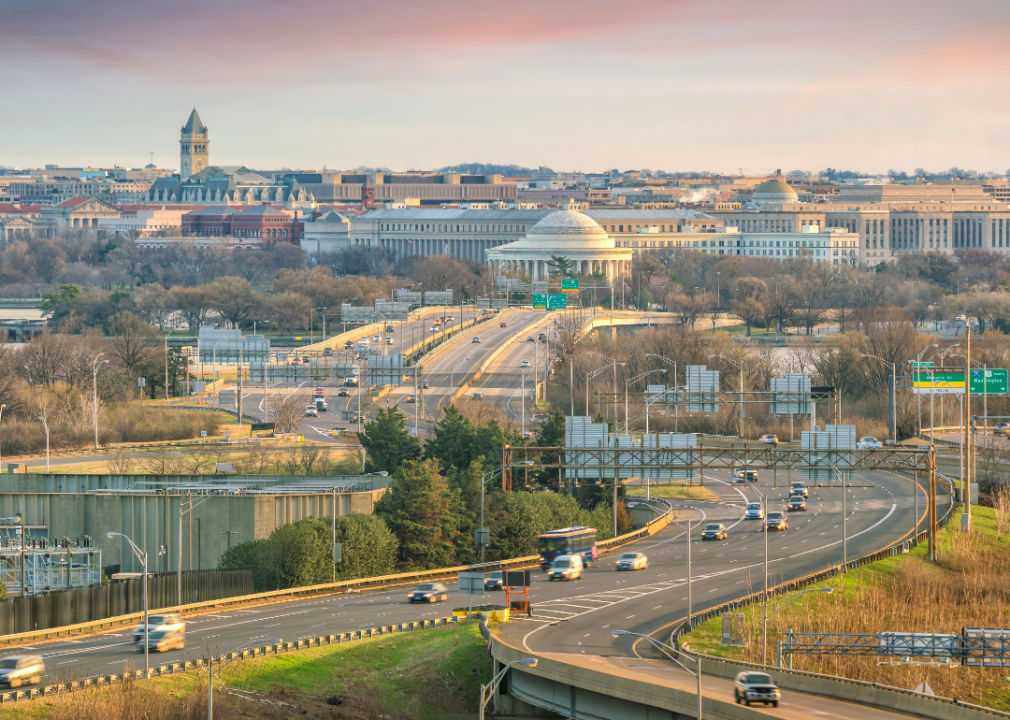
Canva
#1. Washington, D.C.
– Cost of unmaintained roads per person: $1,100
– Miles of road in poor condition: 402
– Bridges in poor condition: 7
– Infrastructure report card grade: C
– Expected funding for highway and bridge programs: $1.3 billion
While Washington D.C. received a B- from the 2021 Report Card for America’s Infrastructure, the same organization gave the region a D+ when it came to its roads. Some of the worst roads in the area include Interstate 395, D.C. Route 295, and Interstate 495 where many accidents take place. The seat of government’s ironic need for better infrastructure will hopefully be aided by an infusion of federal funds. The District Department of Transportation already has numerous projects in play, among them the Rehabilitation of the 16th Street Bridge over Piney Branch Parkway Project and the revitalization of Martin Luther King Jr. Avenue.
This story originally appeared on RateGenius
and was produced and distributed in partnership with Stacker Studio.
